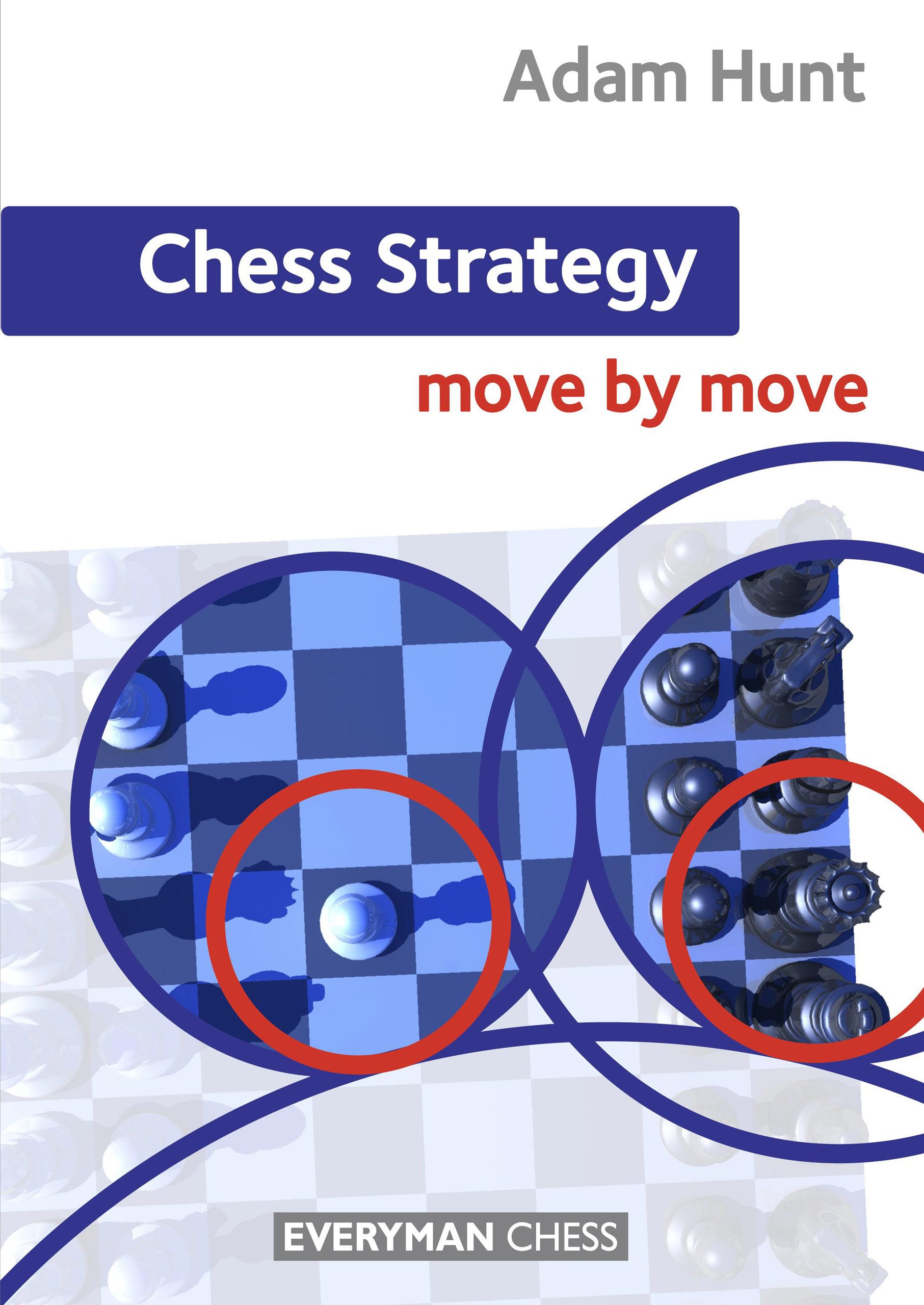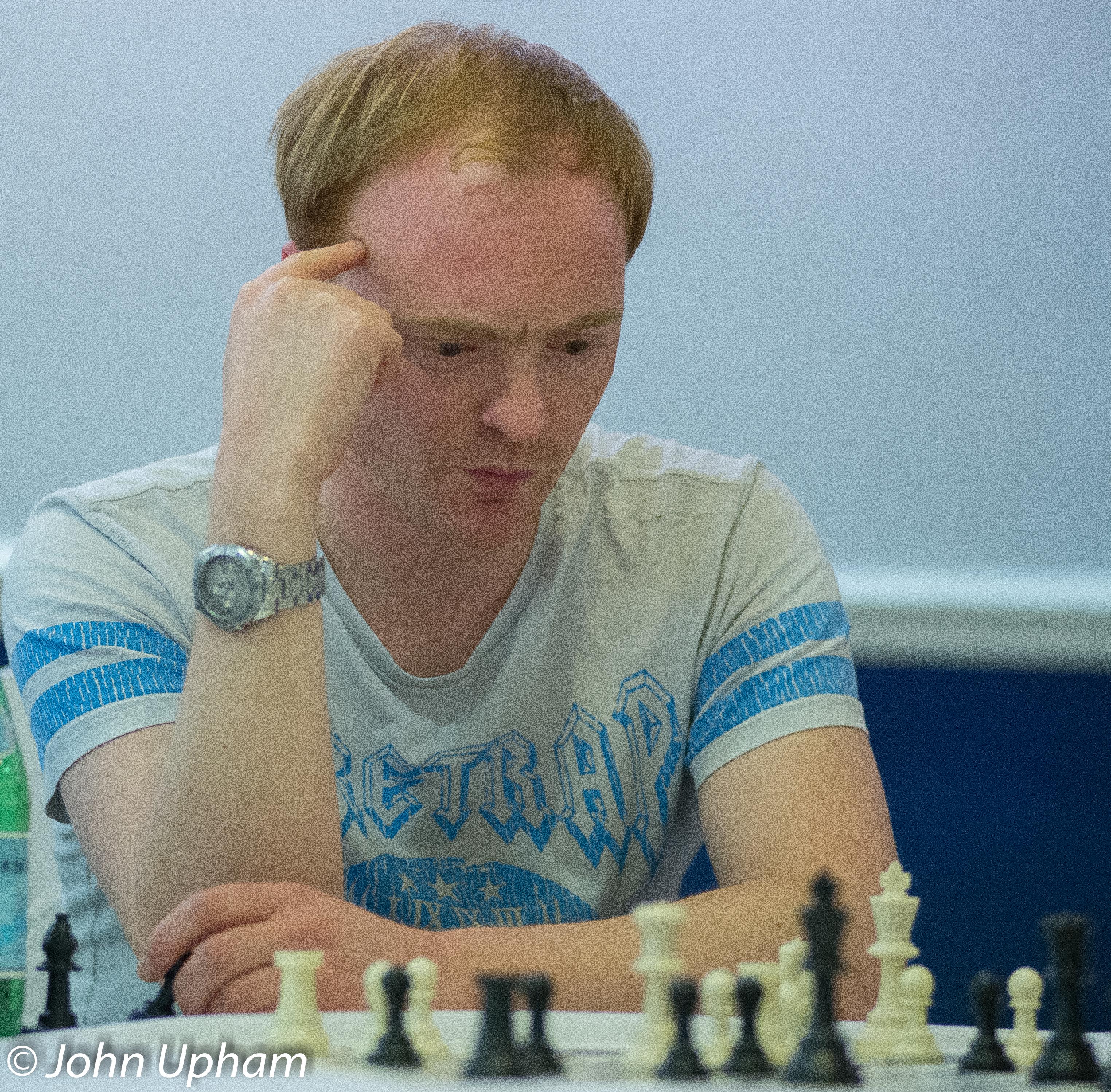The British Chess News team wishes all of our readers, viewers, listeners, tweeters and posters all the very best for the new year !
John, Richard, Richard, Andrew, Colin, Colin, Tony and John
From the Publisher, Thinkers Publishing:
“The Sicilian Scheveningen Defense is a highly respected and flexible variation of the Sicilian Defense, characterized by the pawn structure Black adopts with pawns on e6 and d6. It arises after the moves 1. e4 c5 2. Nf3 d6 3. d4 cxd4 4. Nxd4 Nf6 5. Nc3 e6. This setup allows Black to maintain a solid central presence while keeping options open for dynamic counterplay.”
About the Author:
“Grandmaster Daniel Gormally is currently living in Alnwick, Northumberland, England.
Danny has been a chess professional for over twenty years, in which time he has played in many tournaments both in the U.K. and abroad. He has represented England in the European team championships and the Olympiad. He has taken a high placing in the British chess championships and on several occasions has been placed in a tie for second. He is also the two times winner of the English rapid play championships.
In 2005 he scored his final Grandmaster norm in a tournament in Gibraltar, where he scored a 2693 performance. In that tournament he played against several world-class grandmasters, including Nakamura, Aronian, Sutovsky and Dreev, and only lost one game.
He is also the author of several well-received chess books, including “A Year in the Chess World” and “Mating the Castled King”, one of the few western chess books in recent years to be translated into Chinese.
As an author he is known for his laid-back and humorous style, this is his fourth book for Thinkers Publishing.”
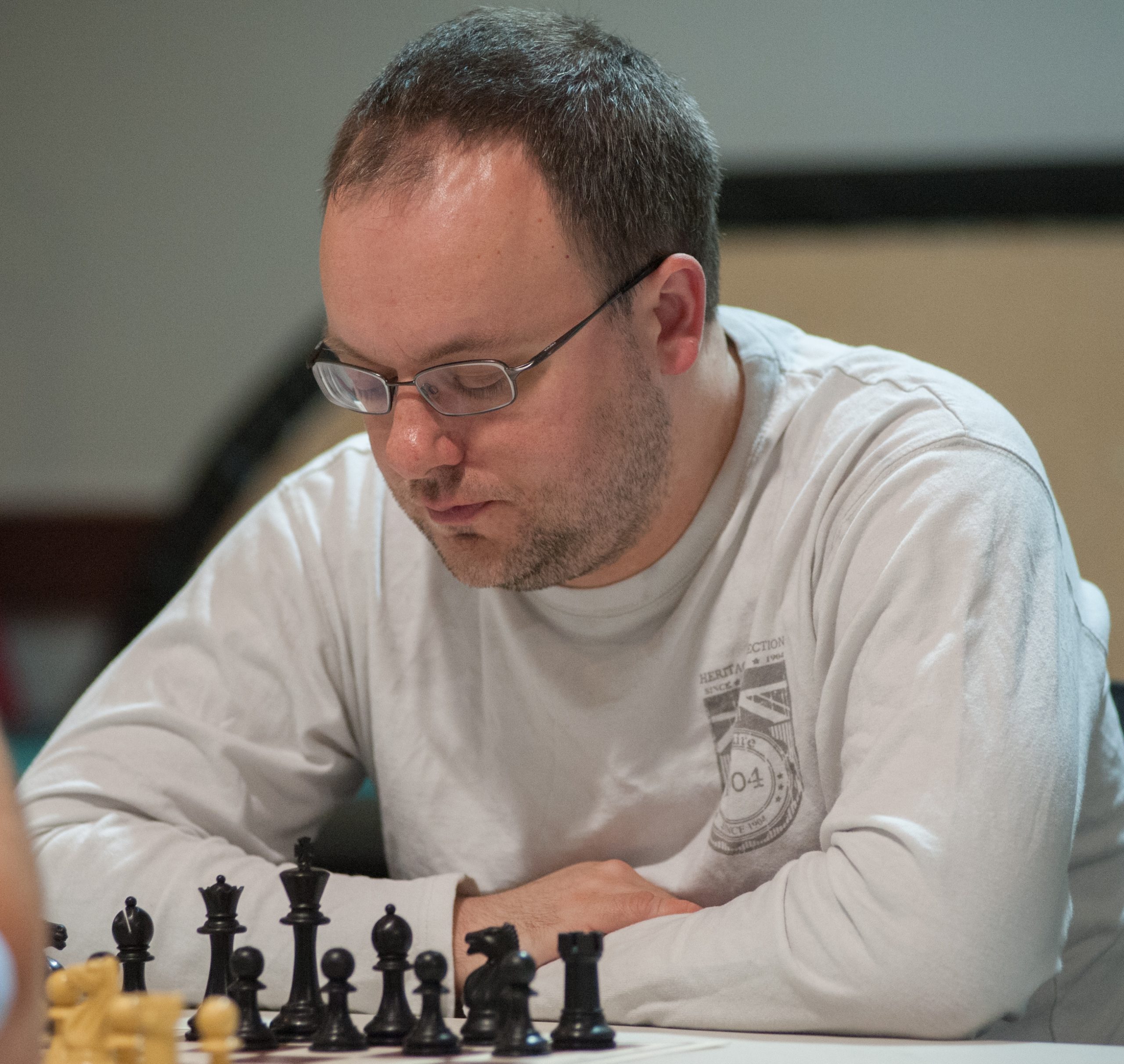
This book is divided into eighteen chapters:
Chapter 1 – Tabiyas
Chapter 2 – The Chess Detective
Chapter 3 – A historical perspective
Chapter 4 – Kasparov vs Anand 1995
Chapter 5 – Engine analysis
Chapter 6 – Training games vs the engine
Chapter 7 – Chef’s recommendations
Chapter 8 – Turbo calculation
Chapter 9 – Defusing the most dangerous lines
Chapter 10 – Evaluations
Chapter 11 – Scheveningen Problems
Chapter 12 – Online adventures in the Scheveningen
Chapter 13 – 6.Bg5
Chapter 14 – Keres vs Nakamura
Chapter 15 – Delving deeper
Chapter 16 – Pawn breaks/structures
Chapter 17 – Tips for playing the Scheveningen
Chapter 18 – Exercises
The Scheveningen is not a trendy variation but there are a number of elite level players who have been proponents of this Sicilian variation such as Garry Kasparov and the current World Champion Gukesh Dommaraju.
The author, Danny Gormally explains in the Introduction section that “this isn’t your average chess book and I don’t sift through each and every variation and line in the typical way of most openings tomes, partly because I don’t find such opening books particularly enjoyable to read so have no desire to inflict them on the reader either”.
This book is therefore not a theoretical treatise on the trendy theory or otherwise of the Scheveningen Sicilian. There is some theory but there is not a dense thicket of complex, variations chapter after chapter. The author aims to explain the typical ideas, plans and pawn structures in this opening: in this he largely succeeds.
Danny also gives general advice on how to study an opening and on how to improve at chess. He obviously advocates the use of strong chess engines but stresses that over reliance on engine preparation without understanding, learning how to calculate and evaluate is harmful.
Chapter 1
This is a short chapter that introduces a couple of key positions in the Scheveningen: here is one from the Classical variation:
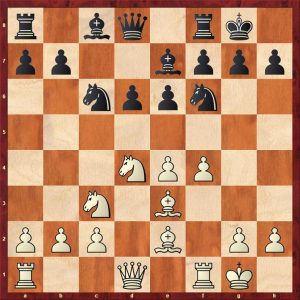
The modern way to play this position is 9…e5 which equalises: the explanation given by the author is logical and illuminating. The older, more traditional move 9…Bd7 is a perfectly acceptable alternative which is covered in Chapter 7.
In the chapter summary, the author gives some sensible advice:
“play some training games from that position, perhaps against the computer or against a training partner. Study the position on Chessbase or some other kind of program…. That way you get a feel for the most familiar and most important positions in that opening variation. But it must be said, though, that there is no substitute for practical experience…. you analyse those games afterwards – the trail-and-error advantage of that is quite huge.”
Chapter 2
This section is a key chapter where the author gives general advice on studying positions:
Seven exciting and didactic games from the Scheveningen are analysed with an emphasis on the opening/early middlegame plans for both sides. Five of these are in the Classical line, one in the English Attack, one in the dangerous f4/Be3/Qf3 or g4 line.
Classical Variation
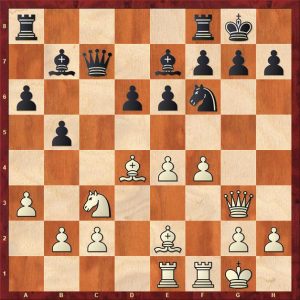
This position is discussed at length with the plans for both sides considered. The game continued 14…Rad8 15. Kh1 Bc6 16.Bd3 Qd7
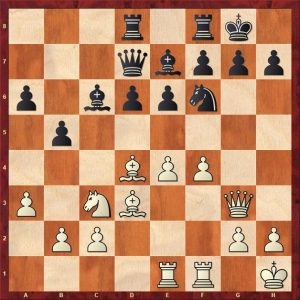
This is a typical position from the Classical variation. White played the tempting 17.Qh3?! eyeing 18.e5 but black has a typical counter 17…e5! (“you should always have the central breaks on your radar”) and Black is slightly better and went on to win a good positional game in the ending.
Here is another typical tabiya from the Classical variation.
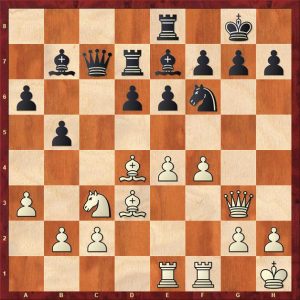
White played 17.Nd1!? which is the computer’s top suggestion. The plan and its resulting ideas and positions are discussed by the author which is instructive. 17…Bd8! was played and is a deft manoeuvre neutralising white’s attacking ideas.
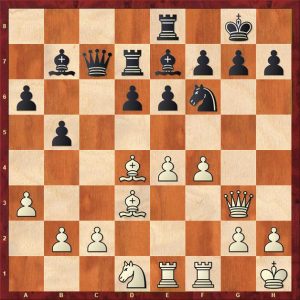
Here Black played the tempting 17…d5? (instead of the patient 17…Bd8) 18.Bxf6! Bxf6 19.e5 with a winning game: buy the book to see the denouement.
English Attack
Black has just responded 9…d5 after White’s queenside castling.
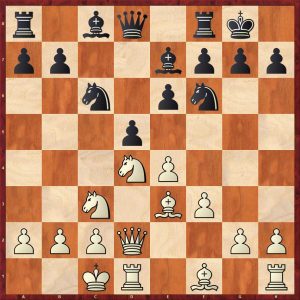
From the author: “A typical liberating central break, and it is my belief that this is the most reliable equaliser in this variation.”
Danny discusses the two major branches here:
A. 10.exd5 Nxd5! 11.Nxd5 Qxd5 12.c4 Qd6!=
B. 10.Qe1 e5! 11.Nxc6 bxc6 12.exd5
Here is another dangerous White system that can be defanged with a little detective work:
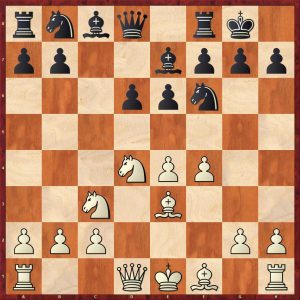
White can play two very aggressive moves which are dealt with in the same way:
8.Qf3 e5!
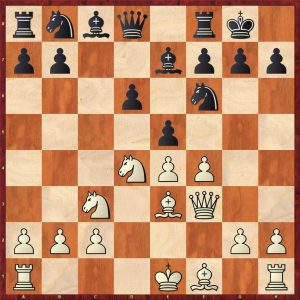
9.Nf5!? (9.Nb3?! Bg4! 10. Qf2 d5! opening up the game as white has lost time with his queen) 9…Bxf5 (removing a piece that has moved 3 times) 10.exf5 Nbd7= Black has excellent development with Rc8 to follow.
8.g4 e5!
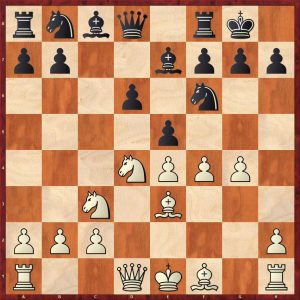
The central strike completely disrupts White’s attacking build-up.
9.Nf5 Bxf5 (removing the dangerous knight that has moved 3 times)
10.gxf5

Superficially, this position looks good for white with the half open g-file, bishop pair and more space: he only needs to play Qf3, 0-0-0 and Rg1 with an excellent position. However, Black is well developed, is to move, and has two excellent plans.
A. 10…Nbd7 11.Qf3 Rc8 (already eyeing up an exchange sacrifice on c3)
B. 10…exf4 11.Bxf4 Qb6! (A lovely disruptive move eyeing the weak dark squares and exploiting White’s lack of development, a typical idea in many openings particularly in the Sicilian) 12.Qd2 Qxb2 13. Rb1 Qa3 unclear
Taking Danny’s general advice here, the reader should analyse this unclear position on their own and evaluate the resulting positions. Use the engine to check your work but don’t use the engine as a crutch all the time which can lead to laziness.
Chapter 3 – A historical perspective
The author puts the opening into its historical context citing Max Euwe as one of the major developers of the Scheveningen. Paul Keres’ 6.g4 is introduced with a crushing win by Keres over Efim Bogoljubov in 1943. Danny restores the Black players’ sanity with a excellent game by Garry Kasparov holding Anatoly Karpov in their first World Championship match in Moscow 1984.
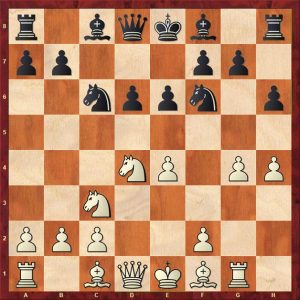
Kasparov played the interesting 8…h5!? and drew an exciting tussle.
Modern theory prefers the immediate central counterattack with 8…d5! which the author recommends.
Chapter 4 – Kasparov vs Anand 1995
This is an historical chapter with games from the Kasparov – Anand match in 1995. All three games covered are high quality encounters including a fine victory by Anand in game 9. The reviewer won’t say anymore as these games are fairly well known and the book covers them well.
Chapter 5 – Engine analysis
This short chapter discusses the pros and cons of using an engine in analysis. Clearly using an engine is a vital tool but “too much dependence on chess engines, as I know from my own experience, can make you lazy and you don’t activate your own thinking processes.”
“It is vital to do your own analysis….”
Four combative tussles are subjected to engine analysis which is illuminating to say the least.
Chapter 6 – Training games vs the engine
Four games are included with the author playing White: two in the Keres attack, 1 in the Sozin and 1 in the English attack.
The last game with the engine defending against the English attack is an excellent counterattacking game.
Chapter 7 – Chef’s recommendations
This is an important chapter where the author gives his recommended lines against White’s most dangerous tries:
I won’t give any more spoilers here: buy the book to find out.
Chapter 8 – Turbo calculation
The author states: “In this chapter I want to test, and hopefully turbo-charge the readers’ calculation. Calculation is so important, and all the better younger players now work on this aspect of the game.”
Six exciting positions are given and the reader is invited to calculate the consequences of a particular move. Here is example 4:
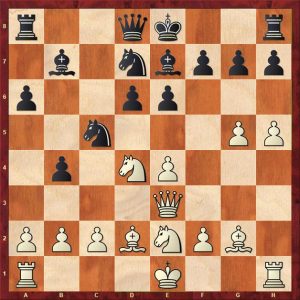
The author asks: is 14…d5 15.exd5 Nb6 good for Black or not ?Calculate and check your answer in the book.
The chapter summary gives some useful concrete tips.
Chapter 9 – Defusing the most dangerous lines
In this chapter the author plays training games with Black against the engine, sees what the engine does to defeat him, then switches colours to see how it manages to defuse these “dangerous” attempts. The Classical and Sozin lines are covered. The importance of move order is also highlighted in certain lines.
Chapter 10 – Evaluations
“So, I would strongly recommend that you spend time checking your games and get into the habit of evaluating positions. If you don’t know how to evaluate positions then what is the point of calculating, as you won’t know what to aim for anyway?”
There are 6 tough positions to evaluate.
Here is the second position:
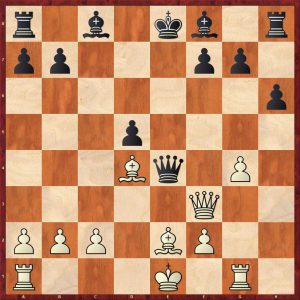
The solution is in the book.
Chapter 11 – Scheveningen Problems
“In this chapter I am going to pose you problems relating to the course. How sharp are you tactically? Let’s find out! And don’t be concerned if you get a lot of these wrong. I probably would as well. The main thing is not that you get them right, but that it gets you thinking about the opening.”
Here is the last of 11 positions:
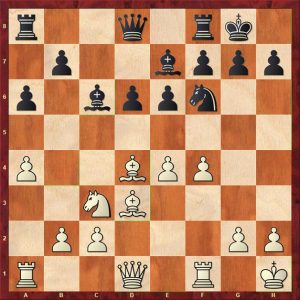
Chapter 12 – Online adventures in the Scheveningen
Danny dissects four of his on-line games, three as Black and one as White in the Scheveningen.
The chapter summary is sensible advice.
Chapter 13 6.Bg5
This is an important chapter as 6.Bg5 can lead to transpositions to the Richter-Rauzer or the Najdorf or a hybrid Sicilian.
The reader should examine these games/move orders carefully.
Here is a good example:
1.e4 c5 2.Nf3 e6 3.d4 cxd4 4.Nxd4 Nf6 5.Nc3 d6 6.Bg5 Be7 7.f4 0-0 8.Qf3
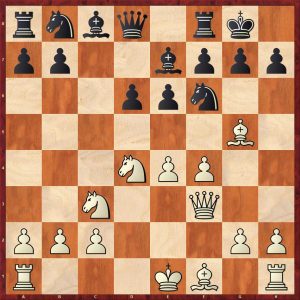
8…e5! disrupts White’s attacking build-up
Chapter 14 Keres vs Nakamura
In this chapter, Gormally discusses Nakamura’s approach when facing the Keres Attack. The main theoretical recommendation is this book is 6…h6, but Nakamura plays 6…a6 and b5. This line is very dangerous for Black but just about playable. The chapter summary shines some light: “Computers have shown that most opening lines are defendable, and even though Black is under pressure in this early a6 line against the Keres attack, the counterattacking possibilities are obviously there.”
Chapter 15 – Delving deeper
In this section, the author discusses one of the key lines in the Keres attack. But before analysing two interesting games, Danny gives some general advice.
“Not that it is particularly productive to prepare for hours on end before a chess game, at all. I firmly believe that chess players spend too much time preparing for opponents, and not enough time preparing themselves….. it is clearly responsible to do SOME preparation.”
The line is question occurs after these moves:
1.e4 c5 2.Nf3 e6 3.d4 cxd4 4.Nxd4 Nf6 5.Nc3 e6 6.g4 h6 7.h4 Nc6 8.Rg1 d5!
There are two critical lines:
Buy the book to learn more.
Chapter 16 – Pawn breaks/structures
Fourteen excellent examples are given.
Here is the sixth example:
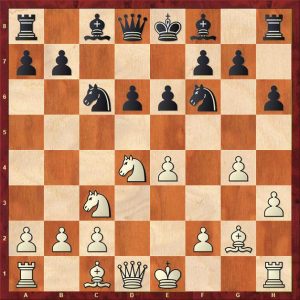
8…?
Chapter 17 – Tips for playing the Scheveningen
This chapter gives some useful general advice on studying openings and preparation. Also included is general advice on improving at chess.
Chapter 18 – Exercises
The book finishes with an excellent set of 25 exercises: find the best move.
Here is exercise 8 (Black to play):
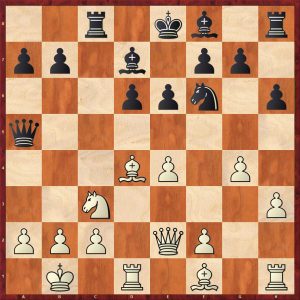
Summary
This is an unusual book in its structure with a pot-pourri of chapters on different topics. It is not a traditional opening survey book which is the book’s strength and its weakness. The book is packed full of good advice on the main variations of the Scheveningen Sicilian concentrating on typical plans; pawn structures; manoeuvres as well as some concrete variations. The book also gives excellent advice on how to study openings generally and on how to improve at chess. The reviewer feels that a really ambitious player would need more details of concrete lines which the author acknowledges and Danny gives advice on how to build up a database of games that would cover all the major theoretical lines.
The reviewer recommends this excellent book.
FM Richard Webb, Basingstoke, Hampshire, 24th December 2024
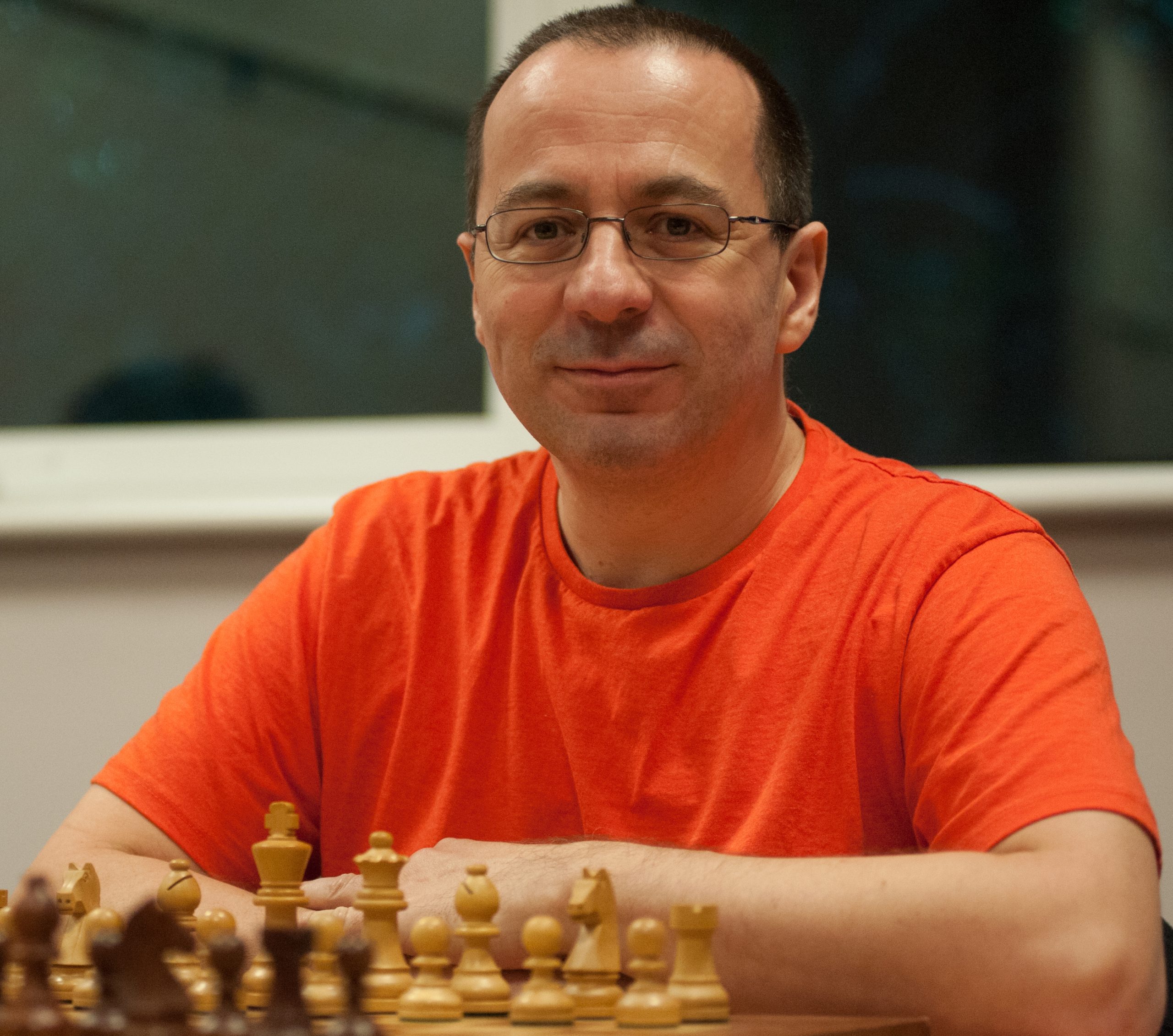
Book Details :
Official web site of Thinkers Publishing
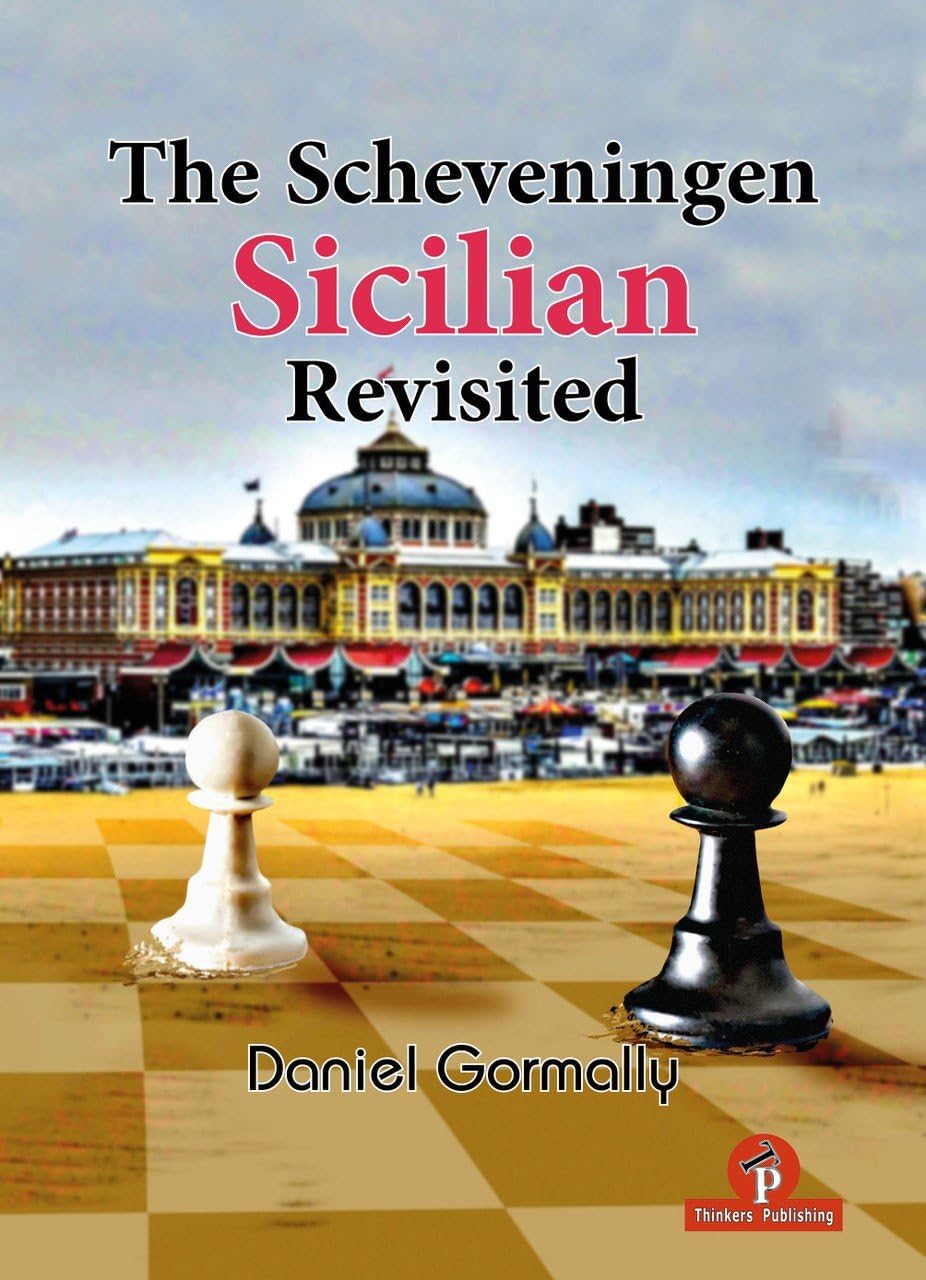
The 1920s saw the beginnings of chess competitions for juniors. In 1921 a boys’ tournament took place in Hastings: this was repeated in 1922 and by 1923 had become the official British Boys’ Championship, for those under the age of 18. The first winner was Philip Stuart (later Sir Stuart) Milner-Barry.
That year the London Chess League decided to run their own championship for boys, starting on 31 December 1923, so you might just about claim that 2024 marks its centenary. It’s still going strong under the name of the London Junior Chess Championships.
The tournament took place, along with two sections for adult players, at St Bride’s Institute, which would remain its venue for many years. Sir Richard Barnett, whom you met last time playing chess on a liner in 1930 before sailing off into the sunset, was on hand to open the congress, advising the contestants to put ‘safety first’.
In these days of pre-teen grandmasters and an 18-year-old world champion, it’s salutary to consider how, just a century ago, the whole idea of teenagers playing chess was considered strange. The press commented on how well they played, and on how they used up most of their time on the clock.
The tournament attracted ten players, and press interest was such that we have all their initials and surnames, and, in some cases, their schools. Of course it doesn’t help that one of the competitors was J Smith, but we can at least have a stab at identifying all of them. While most of them grew up to have fairly anonymous lives (mostly) away from the chessboard, two of them had more interesting stories to tell, one inspirational, the other disturbing.
The first story I’d like to tell is that of Max Black. Born in 1909 and a pupil at Dame Alice Owen’s School in North London, he was one of the younger competitors. In spite of his relative youth he scored 6/9, finishing in third place.
Max’s father Lionel was a wealthy Jewish silk merchant, born in Kyiv, but, by 1909 living in Baku where Max (like Garry Kasparov many years later) was born. In 1912, deciding that Russia wasn’t a safe place for a Jewish family, Anglophile Lionel, his wife and two young sons (Max had now been joined by Misha) moved to England, translating their name from the Russian Tcherny to Black. Two more children would be born there: Samuel (Sam) and Rivka (Betty).
Here, in a family photo from an online tree, you can see the family at some point in the mid 1920s.
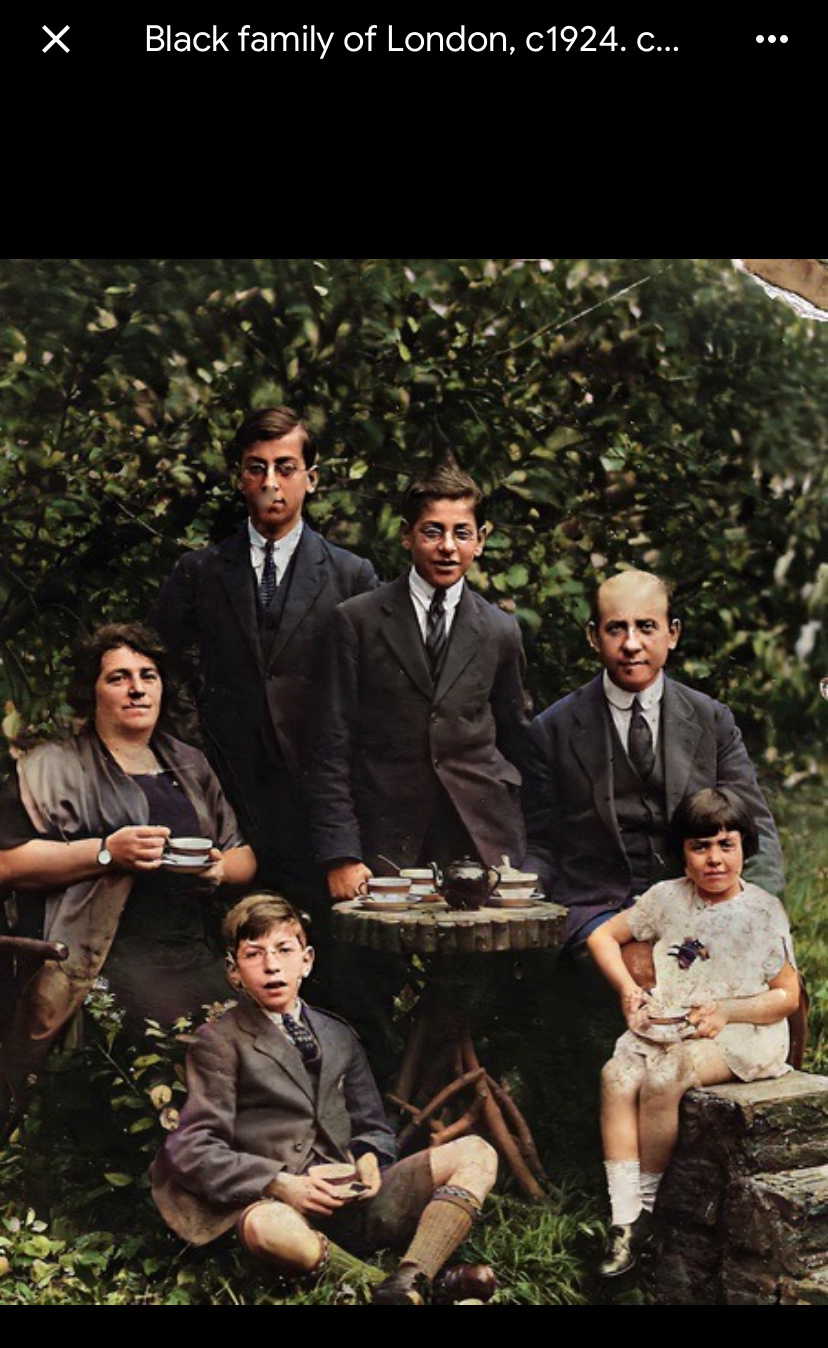
Max played in the London Boys’ Championship for the next three years (I’ll tell you how he fared another time) before graduating to adult chess in 1928. By this time he was reading mathematics at Queens’ College Cambridge, and was also moving in the same circles as the leading philosophers of the day, such as Bertrand Russell and Ludwig Wittgenstein.
He was selected to play on board 5 in that year’s Varsity match, where he faced future Communist spy Solomon Adler.
He was losing for much of the game, but, after Adler made an instructive error just before adjudication, he was fortunate to be able to share the point. (As always, click on any move in the game for a pop-up window.)
Max entered the 1928-29 Hastings Congress where he was placed in the Major B section, won by his contemporary C H O’D Alexander.
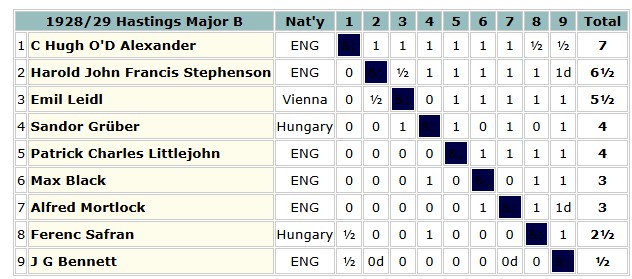
He lost this game against another talented teenager, where he made a couple of understandable defensive errors against Mortlock’s kingside attack.
In the matches preceding the 1929 Varsity Match Max won two games against Maurice Goldstein, one of the strongest London amateurs of his day.
Here’s one of them.
It’s interesting to observe in these games that players were experimenting with openings (the Pirc Defence and the Benko Gambit) which would only become established several decades later.
In the Varsity Match itself he again faced Solomon Adler, this time getting crushed with the black pieces after playing the opening much too passively.
Max’s next appearance was in the 1930 Varsity Match, by which time he’d reached the heights of Board 2, facing (Arthur) Eric Smith.
Again, he was lucky to escape with a draw after the future Canon missed a couple of wins.
But that was to be the end of his competitive chess career, as, on completing his studies he chose to devote himself to his academic and family life.
After graduating in 1930 Max spent a year studying in Göttingen, before taking a post teaching mathematics at the Royal Grammar School in Newcastle, at the same time writing his first book, The Nature of Mathematics: a Critical Survey. In 1936 he returned to London, lecturing in maths at the Institute of Education (part of University College London). In 1940, switching from maths to philosophy, he accepted a post at the University of Illinois, before becoming a philosophy professor at Cornell University in 1946. He remained at Cornell until his retirement in 1977, but continued lecturing worldwide until his death in 1988.
Describing himself as a “lapsed mathematician, addicted reasoner, and devotee of metaphor and chess”, he maintained an interest in chess throughout his life. He is particularly noted for the ‘mutilated chessboard’ problem, devised as means of demonstrating critical thinking. Take a chessboard with two opposite corners removed. Is it possible to fill the whole board with 2×1 dominoes? If you stop and think for a moment, the solution is obvious, but not everyone is able to think like that.
His celebrity chess opponents included Arthur Koestler, whom he beat in four moves, and Vladimir Nabokov, whom he beat twice, neither game lasting more than 15 minutes. It’s said that he gave displays of blindfold chess and, even in his late sixties, gave simultaneous displays against up to 20 opponents.
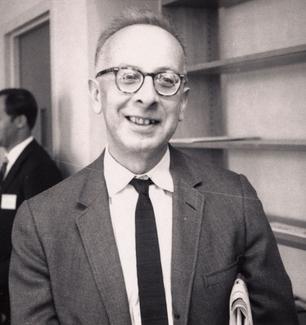
I would suggest to you that, as an analytical philosopher, searching for meaning in language, mathematics, science and art, promoting logic and critical thinking, Max Black was one of the most important figures of the 20th century you probably haven’t heard of. It’s gratifying to know that, in his teens, he took part with distinction in the first four runnings of the London Boys’ Chess Championship.
If you’re interested you can read more about him on Wikipedia and MacTutor. You’ll find lots more online as well: Google Books and Amazon Books are both helpful.
His brothers both achieved eminence as well, in very different fields. Sir Misha Black, who wasn’t a competitive chess player, was an architect and designer noted for the street signs in Westminster and for designing trains for British Rail and the London Underground. Sam Black, the youngest of the three brothers, was also an alumnus of the London Boys’ Chess Championship, and had a very distinguished international career in the field of public relations while at the same time practising as an optician. A lifelong chess player, he was Secretary of Finchley Chess Club and President of the North Circular Chess League, who still run an annual blitz tournament in his honour.
While Misha Black was campaigning for peace in the 1930s, one of Max’s opponents was following a very different path.
Clement Frederic Brüning , as the youngest player in the competition, attracted some media attention.

He finished in last place, with a score of 2/9, but, undaunted, he also took part in the British Boys’ Championship a few months later, drawing with the eventual winner Wilfred Pratten in his preliminary group and finishing runner-up to Alfred Mortlock in his section of the finals.
Like Max Black, Clement came from an immigrant background. While Max was the oldest child of Russian Jewish parents who were first generation immigrants, Clement was the youngest of five sons of a German Catholic father and an English mother.
Carl Alexander Marcell Brüning (usually known as Marcell) seems to have come to England from Cloppenburg in Lower Saxony in about 1890 along with his brother Bernhard, assisting their older brother Conrad’s coal merchant’s business. The 1891 census found the family in Hampstead, and in 1901 Bernhard and Marcell were boarding in Kingston. In 1903 Marcell married Clara Mary Bagshawe, from a prominent Catholic family, whose Uncle Edward had recently retired as Bishop of Nottingham.
At this point Clara and Marcell were living a peripatetic life, living in Rochford, Essex, Newcastle, back to Rochford and then to New York, presumably for his coal dealing business. During these peregrinations, five sons were quickly born: Guy, Maurice, Roland, Peter and finally Clement in 1911.
Here, in a family photograph, is a smiling young Clement on his rocking horse.
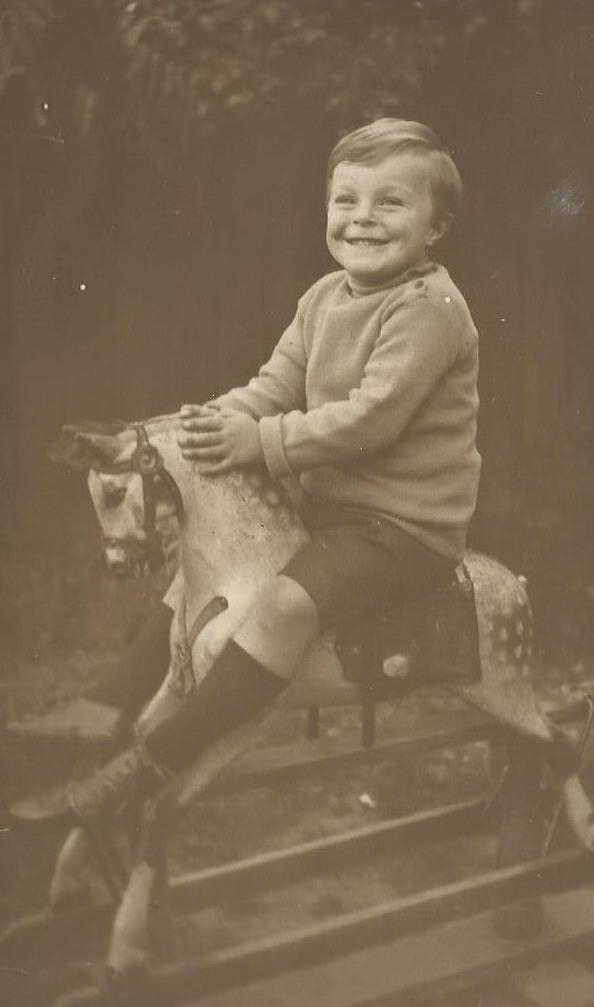
In 1921 most of the family were still abroad, but Clara was visiting her father in Chiswick (I used to have a pupil in the next road) while Guy, taking a break from his studies, was on holiday in Westcliff on Sea, near Southend and not far from his place of birth.
They must then have returned to settle in Ealing, the Queen of Suburbs, living in a large detached house just west of the Broadway. Clement was enrolled as a pupil at Ealing Priory (now St Benedict’s) School, which was where we found him in 1924.
Clement competed in both the London and British Boys’ Championships in 1925. In the latter event he shared third place in the top section, again drawing with Pratten in a game he should have won.
John Saunders comments in BritBase:
Sources: Staffordshire Advertiser, 16 May 1925; BCM, May 1925, p216. The score of the game in BCM (from which the newspaper score may have been taken) gives the players as Bruning (White) and Pratten (Black) but the detailed description of the game on p214 makes it fairly certain that Pratten played White in the game: “In the last round Pratten very nearly had a shock. Opening with a Ponziani, which turned into a kind of Ruy Lopez after Bruning had played 3.., P-Q 3, he got a strong-looking game; but Bruning defended so well that the situation changed entirely to the holder’s disadvantage, and at last a sacrifice was obviously Black’s policy. Bruning saw this, but unfortunately sacrificed the wrong piece, and Pratten, by giving up his Queen, for adequate compensation, was able to extricate himself, and a draw resulted.” But we cannot be certain.
The computer informs me that White had an easy win in the final position, but no one seems to have realised this at the time. Insipid, as the Staffordshire Advertiser annotator calls it, it certainly wasn’t.

In 1926 he took part in the same two tournaments, but with less success, this time he performed poorly in his preliminary section of the British, but did manage to win his consolation event.
Perhaps this result was the reason why Clement decided to give up chess at this point.
In 1934, though, by which time the family, perhaps now less well off, had moved a mile to the west, to a semi-detached house in the less prestigious suburb of Hanwell, he was in the papers again, for a very different reason.
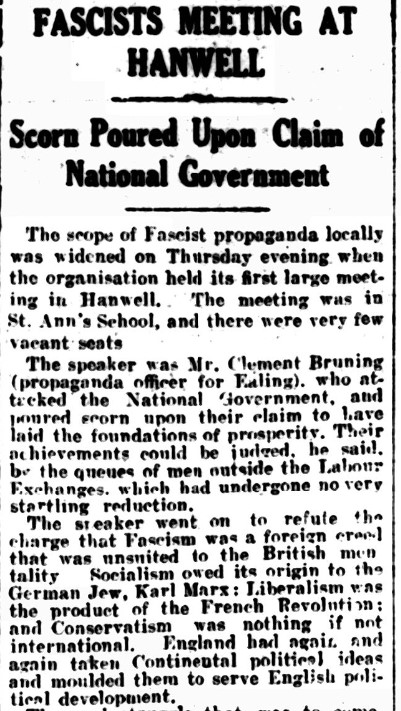
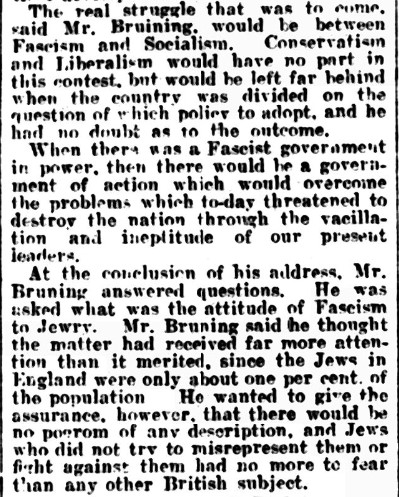
Over the next few years young Clement, clearly a young man with a gift for oratory, played an increasingly important role in Oswald Mosley’s British Union of Fascists, speaking at events around the South of England and writing letters to newspapers. His older brothers were apparently also Blackshirts, but didn’t play a prominent role.
(Another BUF member was aviation pioneer Alliott Verdon Roe, whose mother, Annie Sophia (Verdon) Roe, had been a regular competitor in the early years of the British Ladies’ Chess Championship.)
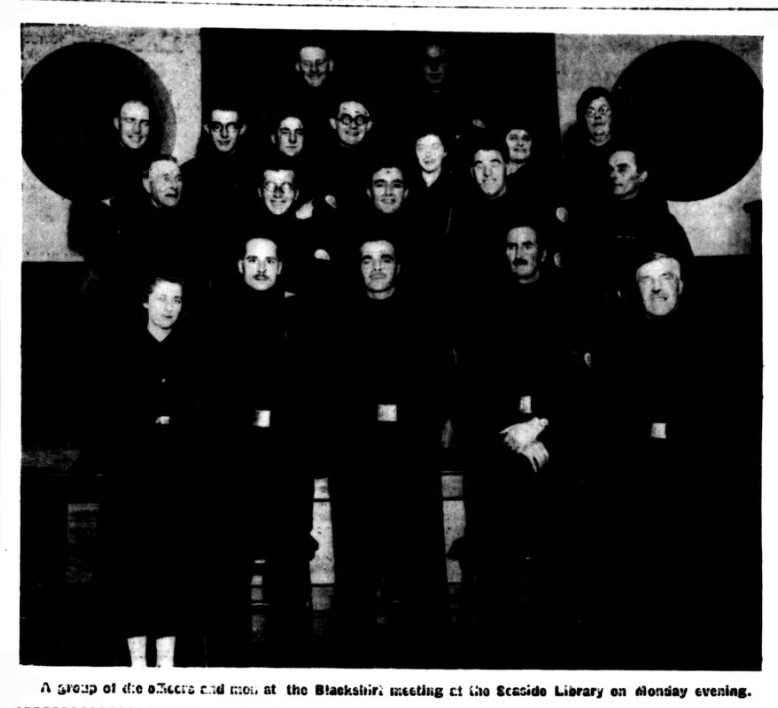
Clement is probably one of the young men in this photograph from a meeting in Eastbourne protesting against the Public Order Bill banning political uniforms: a reaction to the Battle of Cable Street.
A brief quote from the same source:
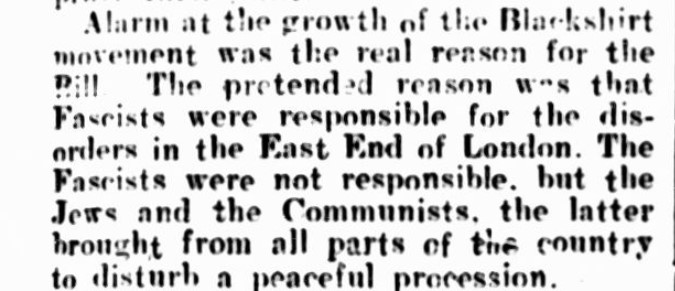
By 1937, and now the prospective parliamentary candidate for the Wood Green constituency, he had risen to the post of Propaganda Administrator for the British Union of Fascists and National Socialists, and was working closely with both Mosley and William Joyce (Lord Haw-Haw).
He was often invited to speak at Rotary Clubs, for instance here in Cheshire.
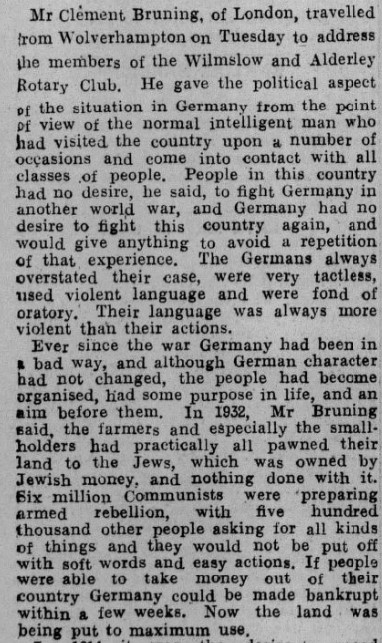
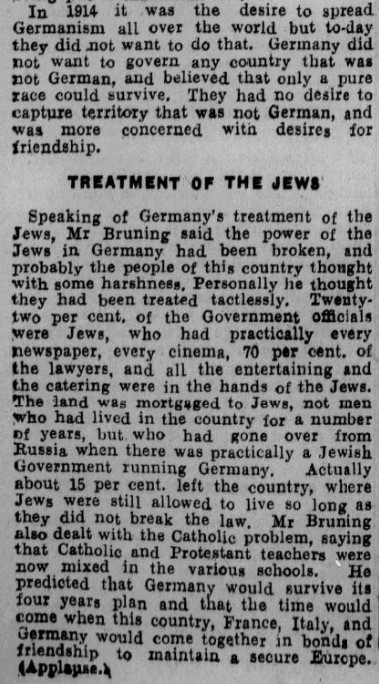
He then moved to Bethnal Green, working for what was by then the British Union, and, when war was declared in 1939, was in Germany, apparently working for Welt-Dienst (World Service), an anti-Semitic broadcasting network.
Then something unexpected happened. He ended up in a concentration camp, where he was murdered by the Nazis on 17 August 1942. What had happened? We know he was being investigated by MI5. Perhaps he’d changed his opinion and fallen foul of the Nazis, or maybe he’d been recruited as a double agent. Nobody knows, or if they do they’re not telling. A very sad and mysterious end for the cute, chubby-cheeked smiling lad on the rocking horse, for the young perpetrator of dashing but unsound attacks in his three years of participation in boys’ chess tournaments.
Two contrasting stories, then, the brilliant mathematician and philosopher whose name was Black, and his rival whose shirt was black, and whose premature endgame resulted in tragedy.
But what of the other eight pioneers of London Boys’ Chess? Their lives, as far as I can tell, took rather more conventional courses.
The tournament winner, with a 100% score, was J Allcock of Coopers’ School, now in Upminster, but then in Bow Road, East London. I believe this was Jack Adams Allcock (1906-1969), who lived very close to the school. He was clearly a promising player, but seems to have played little chess on leaving school. We can pick him up playing for London University in 1928, and in the London League for North London in 1933. His father ran an off licence in Bow, later becoming the landlord of the Duke of York in Hackney, and it seems that Jack and his wife Eliza helped him running the pub. In spite of Jack’s education the family were never well off, both Jack and Eliza leaving very little money. I can’t find any immediate connection with the strong City of London player James Frederick Allcock.
In second place, on 6½/9, was Stanley Thomas Henry Goodwin, born in 1906, and, like Max Black, a pupil at Dame Alice Owen’s School. Also from Hackney, Stanley’s father Vincent was a Post Office sorter. He married in 1932, and the 1939 Register found him living in North London and working as a brewery clerk He served in the Royal Naval Volunteer Reserve in World War 2, and, it seems later emigrated to Australia where he died in Perth, but I don’t have a death date. I have no further record of any chess activity after this tournament.
Percy Geoffrey Husbands (1906-1987) of Regent Street Polytechnic scored 5/9 for fourth place. Percy lived in Ealing: his father Basil was working as a furniture dealer in 1911, but by 1921 he was a house furnisher and decorator, no longer employing servants. In 1934 Husbands became a husband, marrying Lucy Sophia Eavis, whose family owned (and still own) Worthy Farm near Glastonbury. Michael Eavis, the founder of the Glastonbury Festival, is the son of Lucy’s half-brother Joseph Eavis. By 1939 Percy was living in Uckfield, Sussex, working as an Insurance Clerk. His chess career continued in the 1924 British Boys’ Championship and the minor section of the London tournament in 1924-25, but after this event he seemed to stop playing: perhaps work, as it often does, got in the way.
Being confronted by J Smith is a genealogist’s nightmare, and that’s who we have on 4/9. We do know, though, that he was John B Smith of Sir Walter St John School in Battersea, and that he also played in the following year’s tournament. The most likely candidate is John Bryan Smith, born in 1908, the son of a plumber from Wandsworth. He spent much of the 1930s travelling 1st class to and from West Africa, described first as an Assistant and then as a Merchant’s Agent before disappearing from view.
On 3½/9 we find Hugh George Excell (1907-1993) from North London Chess Club. Hugh was the son of an Insurance Claims Inspector from Hackney. He signed up for the Royal Artillery in June 1939, but in September that year was living with his fiancée in Suffolk. Hugh continued playing competitive chess occasionally until at least 1932, including this tournament the following year, and, most notably, one of the first class sections in the 1929 Ramsgate Easter Congress. In the later 1930s he took up correspondence chess, but his chess career seems to have ended with the outbreak of the Second World War.
Here he is, playing in the London Secondary Schools competition (a separate event) in 1925.
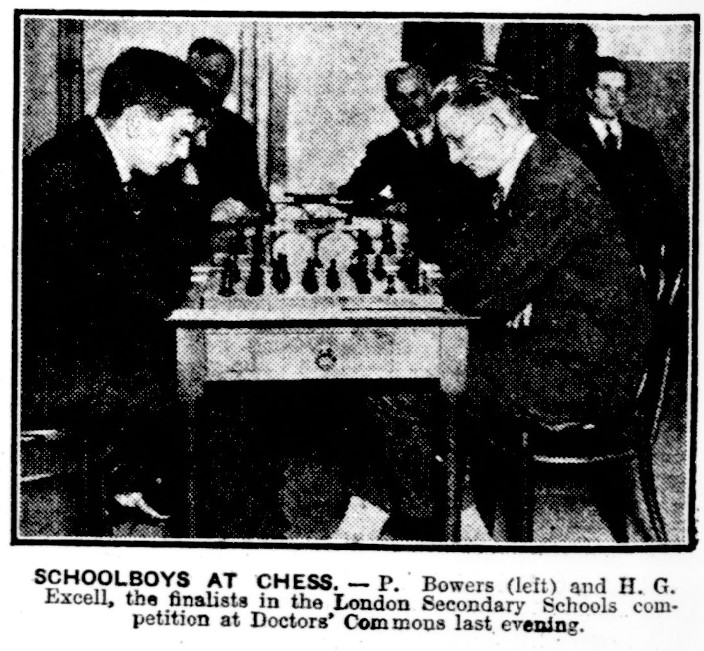
His opponent in this game was Philip Ernest Bowers (1908-1999), who scored 3/9 in the inaugural London Boys’ Championship. Philip was the son of a Police Constable, originally from Norfolk, but who was living in Chelsea by 1921. He was a pupil at Westminster City School, and would also compete in this tournament for two more years. He returned to chess in 1935, by which time he had moved to Birmingham, and rose rapidly through the ranks to become one of his club’s leading players. By 1940 chess activity there was curtailed by the war, and it seems that, like many others, Philip stopped playing at this point. Like many chess players, he spent his adult life teaching maths.
Known as ‘Bill’ rather than Philip, here he is pictured later in life from an online family tree.
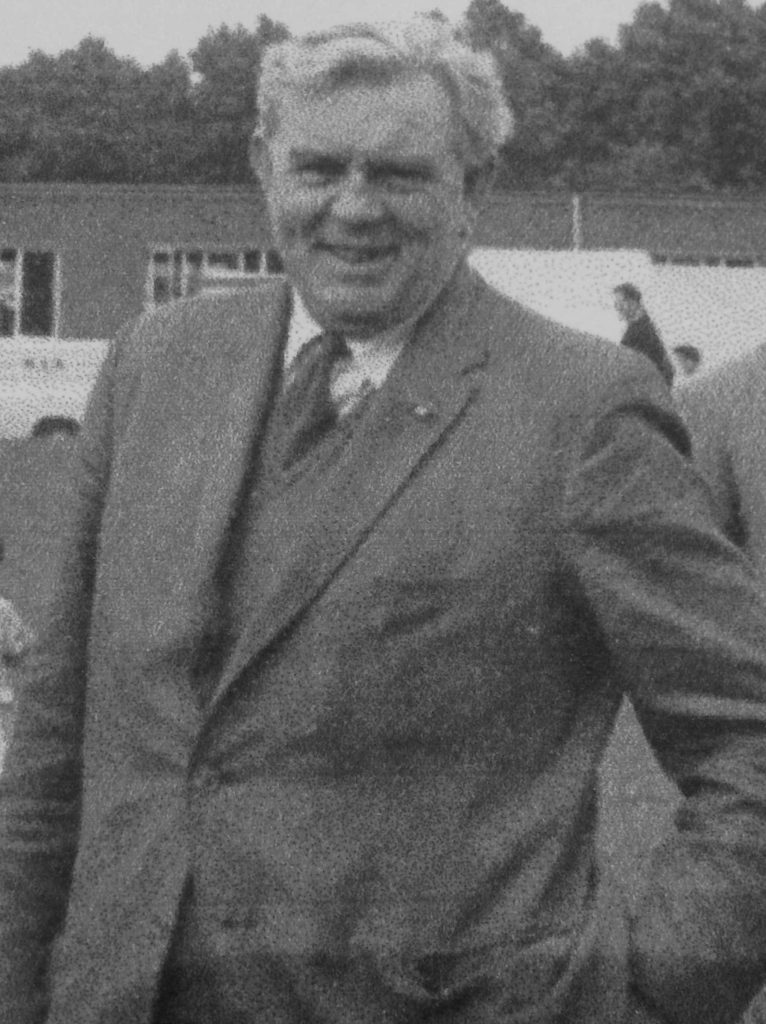
Half a point below him, and half a point above Clement Brüning in 9th place was Jack Liebster (1907-1996), the son of a Russian born GP from Stoke Newington. Both his parents were Jewish, but his mother was born in Stepney: Jack was the youngest of their five children. Chess must have been played in the family: his father is recorded as submitting correct solutions to problems in the London Daily Chronicle in 1901, but this was to be, as far as I can tell, his only experience of competitive chess. In the 1939 Register Jack was described as a Traveller, and also as an ambulance driver. He married a chemist’s daughter in 1941, and they moved to Dunstable, where they had two children and played a significant role in the local Jewish community.
That leaves one other player, variously recorded as JS Lauder or JS Lander, whose score of 3½ left him level with Hugh Excell. I can’t find anyone with that name in the right place at the right time, but I did find Joseph John Lauder (1906-1999), the son of a Scottish born Police Inspector based at Wimbledon Police Station. He was certainly a chess player, and, more importantly, a much respected chess administrator for many years. Joseph (Harry to his friends, Mr Lauder to me) was secretary of both the Surrey County Chess Association and the Southern Counties Chess Union for many years and later, in the 1970s, the SCCU Bulletin Editor. I used to visit his home in Wimbledon every year to collect our club copies of the SCCU Grading List. Quite rightly, the chess players of Surrey now compete for a trophy named in his honour. There’s no way of knowing for certain, but I do hope it was him.
There are no more pre-war chess references, but we can pick Mr Lauder up in the 1939 Register, where he was employed as a Bank Clerk and living in the next road to where he was in the 70s. The first post-war chess record I can find for him is in 1947, playing for his local club. For some years he played regular club and county chess, also enjoying competing at Bognor Regis every year up to 1962. He was a decent, above average club strength player, but it was as an administrator that he deserves to be – and still is – remembered.
There’s much more to be written about the teenage boys who played tournament chess in the 1920s. At some point I’ll introduce you to some of the other LBCC players, and perhaps some of the other competitors in the British Boys’ Championship during that period.
Sources and Acknowledgements
ancestry.co.uk (Black, Brüning and Bowers family trees)
findmypast.co.uk/British Newspaper Archives
Wikipedia
Google Books (search for Max Black and Clement Brüning)
MacTutor
British Chess News
chessgames.com
ChessBase 18/Stockfish 17
Surrey County Chess Association and Southern Counties Chess Union archives/websites
Various other sources mentioned above
From the back cover:
“Chess players can look ahead, formulate a clear plan, and act accordingly. That’s why chess is the perfect learning environment for becoming a strategic expert. But how do you train this? It starts with playing many games and analysing them carefully afterwards.
At the same time, you should learn from the best by studying the games of the world’s strongest players and gradually build their techniques into your play. This book offers you 100 strategic exercises from the games of the best of the best, the World Champions from Bobby Fischer to Ding Liren.
You will learn foundational techniques such as: how to improve your worst-placed piece; how to exploit a lead in development; or make the right piece trade; and how to create a strong square; plus numerous others.
Solving these exercises will help every ambitious club player better understand how to make and execute plans.”
About the Author:
“Thomas Willemze is an International Master from the Netherlands. He is an experienced trainer of amateur players of all levels and has been the National Youth Coach of the Dutch Chess Federation. New In Chess has published his books The Chess Toolbox and The Scandinavian for Club Players and 1001 Chess Endgame Exercises for Beginners – all well-liked by reviewers and customers alike.”

In the introduction to the last book I reviewed, Wojciech Moranda proclaimed: “It is my utmost belief that any author who is seriously interested in helping others excel at chess should treat enriching the public domain with genuinely new training material as a priority.” He adds that “… there is a special rung in hell for authors who shamelessly keep on repeating the same, well-known examples in their books over and over again”.
While I understand where he’s coming from, I don’t entirely agree, and neither, I suspect, does Thomas Willemze. If you’re a subscriber to New in Chess Magazine you’ll know the name from his “What Would You Play?” feature, in which he asks the reader questions taken from amateur games.
Here, though, he introduces his readers to the world champions from Fischer through to Ding Liren, talking about their distinctive styles of play and offering questions concerning strategy taken from their games.
There are similarities and differences with Moranda’s book. While Moranda alternated strategic and tactical questions, Willemze only offers you questions of strategy. While Moranda’s questions give you the chance to play better than the (often very strong) player who failed to find the optimal plan, Willemze’s questions ask you to find the same plan as that chosen by his world champion subjects. Moranda’s solutions are (partially) computer-generated lines showing you what might have happened, Willemze’s solutions show you what happened in the game when the champion opted for the correct plan.
Willemze prefaces each chapter (or ‘part’) with a few pages describing the player’s style and giving a few examples of his play. He’s writing, then, for players who may be less knowledgeable about chess history and won’t have seen most of the positions before. Moranda’s assuming his readers will be well aware of the world champions’ styles and will be familiar with many of their games.
Moranda is writing mainly for very strong and ambitious players with plenty of time available for study.
Willemze is pitching his book at a slightly lower level, ‘club players’ according to the title.
Solving these exercises, he claims, will help every ambitious club player to better construct their own plans in a chess game.
He lists some of the lessons you’ll learn:
Each of the 100 questions is presented in a jumbo sized diagram. Overleaf you’ll discover whether or not you found the solution, followed by a boxed ‘conclusion’ explaining the lesson to be learnt. At the end of each part you’ll find a page of flash cards which you may find useful if you like learning that way.
Let’s turn to a few random examples.
This is Karpov – Malaniuk (USSR Championship 1988). Can you find a way to activate the white bishops?
If you sacrificed the exchange on e7 you found the correct solution.
Here’s the game: click on any move for a pop-up window.
From Miles – Anand (Manila Interzonal 1990): Anand has developed a very powerful initiative on the queenside. What should be his next step?
If you chose Qc8 here, preparing to open up a second front on the other side of the board, you’ve played as well as Anand.
The complete game again:
My final position comes from a Carlsen game you might not be familiar with.
Dourerassou – Carlsen (World U14 Championship Chalkidiki 2003): how, Willemze wants to know, did Carlsen gain the upper hand?
The young Carlsen chose Rd4, to unleash his bishop, appreciating that, once the position opens up it will be superior to the white knight.
You’ll see here what happened next.
Although some of the positions will be familiar to some readers, there are many examples, such as this, from games which will be less well known. Even if you’re very well read, there will be some unfamiliar material here for you.
Willemze has done an excellent job in finding suitable positions for the book, and in offering clear and concise explanations without using reams of computer analysis. This book, I would suggest, is suitable for average or stronger club players, perhaps 1600-2200 strength, with 1800-2000 the main target market. But see what you think from the examples here and in the sample pages.
Production levels are well up to this publisher’s usual high standards, so, if you like what you’ve seen so far, you won’t be disappointed. An enjoyable read which will tell you something about the classical world champions from Fischer through to Ding, and provide you with an array of tools to improve your strategic skills.
You can find out more about the book here and read some sample pages here.
Richard James, Twickenham 21st December 2024

Book Details:
Official web site of New in Chess.
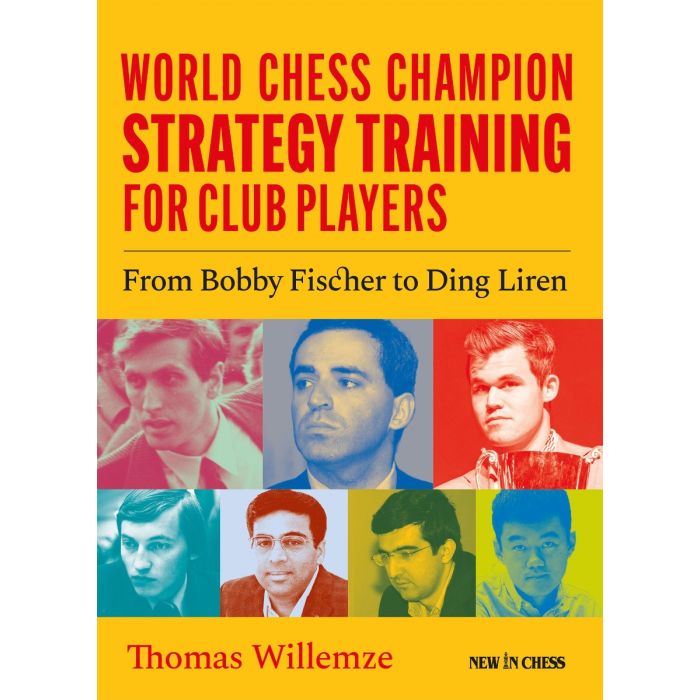
I’ve long been intrigued by this match played on board a liner in 1930.
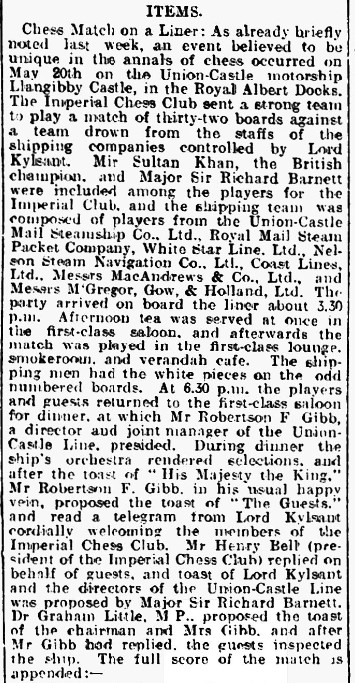
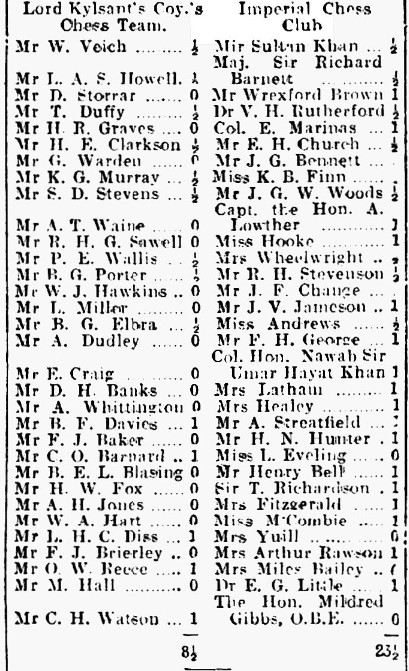
There’s much to be written about the Imperial Club, which played an important part in many aspects of London chess between its foundation in 1911 and the outbreak of the Second World War. It provided a venue for social chess for both Londoners and those from other parts of the British Empire who happened to be passing through, but it was also far more than that. The club was founded by the extraordinary Mrs Arthur Rawson (Ella Frances Bremner): I’ll tell her story, and more of the club’s story in future Minor Pieces.
The list of their players in this match provides a snapshot of their membership, and, more generally, tells us something of the social status of chess in the inter-war years.
Board 1: Sultan Khan (1903-66: Mir, along with Malik, is an erroneous honorific which shouldn’t be considered part of his name) needs no introduction. In this match he could only draw with the little-known W Veitch, although it’s quite likely the result was diplomatic.
Only seven months later he won a Famous Game against none other than Capablanca. For this and all games in this article, click on any move for a pop-up window.
Here he is, on the left, playing against his patron (board 18 in this match).
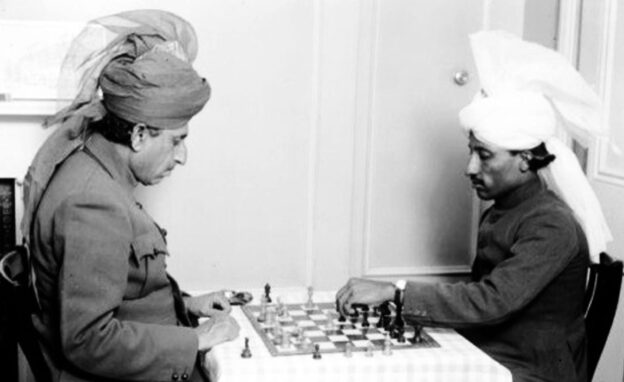
Board 2: Major Sir Richard Whieldon Barnett (1863-1930) – Irish barrister, sportsman (shooting), volunteer officer and freemason, Irish chess champion 1886-89, Conservative and Unionist MP 1916-29. Most of his constituency now comes under Holborn and St Pancras, represented today by Prime Minister Sir Keir Starmer. He died just a few months later, on 30 October 1930, following an operation. You can read an extensive obituary published by the BCM here (scroll down to ‘Barnett’).
Here’s his game from this match, which also looks like a diplomatic draw as he was a pawn up with a probably winning advantage in the final position.
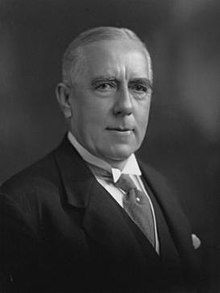
Board 3: Charles Wreford-Brown (1866-1951) – amateur footballer (one of the best of his day, captaining his national team) and cricketer. He didn’t play a lot of competitive chess, but what he did was at a high standard, taking part in the unofficial chess olympiad of 1924 (he lost to Marcel Duchamp in an unlikely encounter between two very different celebrities) and playing in the 1933 British Championship, where he unfortunately had to withdraw for health reasons having won and drawn his first two games. A few years ago I met one of his cousins in a school chess club and was able to show him this game.
Here he is, wearing his England football shirt.
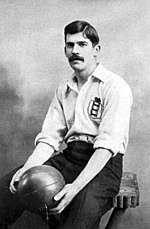
Board 4: Vickerman Henzell Rutherford (1860-1934), politician and doctor. The Imperial Chess Club attracted many politicians, mostly from the Conservative Party, but the splendidly named VH Rutherford was an exception, representing the Liberal Party as an MP before switching allegiance to the Labour Party. The current incarnation of his Brentford constituency, now Brentford and Isleworth, is currently represented by Ruth Cadbury, very distantly related to the Secretary of Richmond & Twickenham Chess Club.
In 1925 Barnett and Rutherford played in the two parallel sections of the First Class tournament at the British Championships in Stratford, both scoring 6/11, suggesting that they were both strong club standard players. EdoChess gives Rutherford’s rating at the time as about 2000. Judge for yourself from this game.
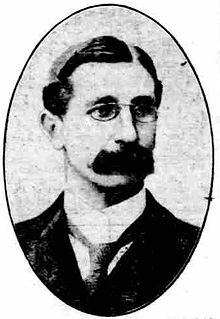
Board 5: Colonel E Marinas: not certain about his identity but there was a Spanish (?) naval officer named Eugenio Marinas around at the time so it might possibly have been him.
Board 6: Edward Harry Church (1867-1947), a pharmaceutical chemist from Cambridge, was a leading light in local chess circles, being President of his club for many years and would later (1938-39) be elected President of the Southern Counties Chess Union. He must have had occasion to spend time in London as well.
Board 7: JG Bennett. I’m uncertain as to the identity of this player. There were two JG Bennetts loosely involved in chess: James George Bennett (1866-1952) was a journalist from Grantham in Lincolnshire: quite a long way from London, but he could have been there on business. There was also a JG Bennett involved in administration and occasionally playing in Kent, perhaps in the Canterbury area, but I haven’t been able to identify him further.
Board 8: Miss Kate (Catherine) Belinda Finn (1864-1932) had been active in Ladies’ chess circles, being a founder member of the Ladies’ Chess Club in 1895, as well as winning the British Ladies’ Championship in 1904 and 1905. For further information see John Saunders here.
She’s on the right here, playing in the 1905 British Ladies Championship.
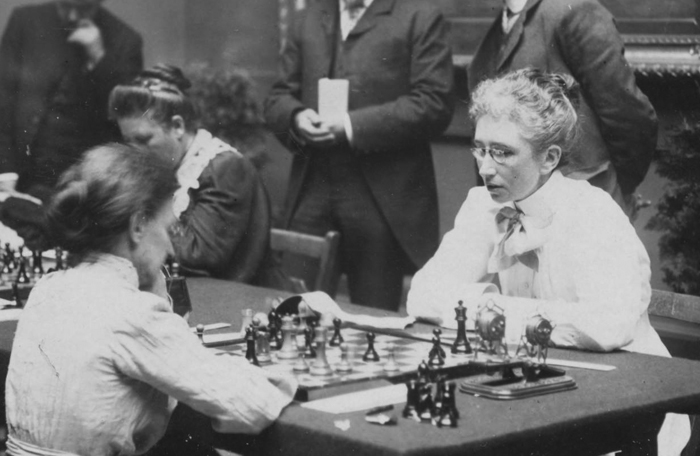
Board 9: this must be John Goodrich Wemyss Woods (1852-1944), a retired schoolmaster (second master and mathematics teacher at Gresham’s School, Norfolk) and amateur artist. The only other chess reference I can find for him is helping to provide some annotations to a game played by a fellow Imperial member some years earlier.
Here’s one of his paintings.
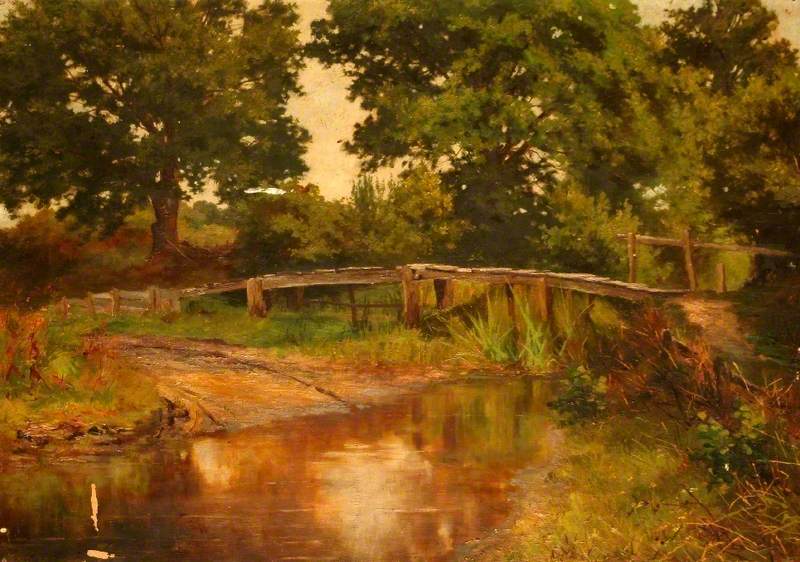
Board 10: Hon. Arthur James Beresford Lowther (1888-1967) was a barrister who served in the First World War (see here), After the war he became Assistant Commissioner for Kenya (1918-20) and later Aide-de-Camp to the Governor of Southern Rhodesia in 1923. On his return to England he took up competitive chess, finishing runner-up in the 2nd Class tournament in the 1927 British Championships.
Board 11: Miss Alice Elizabeth Hooke (1862-1942), who has featured in earlier Minor Pieces here and here. She was a chess player and organiser, sharing first place in the 1930 and 1932 British Ladies Championships.
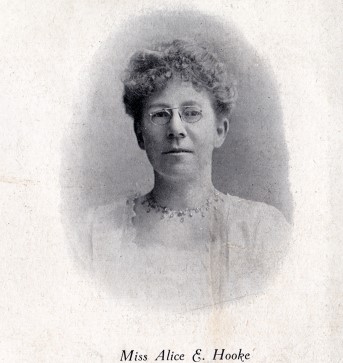
Board 12: Mrs Amy Eleanor Wheelwright, née Benskin (1890-1980), another of the strongest lady players of the period, sharing first place in the 1931 British Ladies Championship, and taking the runner-up spot in 1933. Here she lost to the tournament winner, a member of Sir Umar Hayat Khan’s entourage.
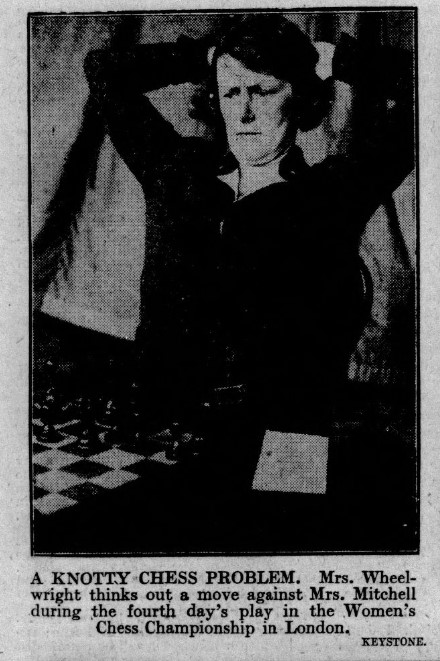
Board 13: Rufus Henry Streatfeild Stevenson (1878-1943), later the husband of Vera Menchik and Hon. Secretary of the BCF, was one of the most important figures in British chess in the inter-war years as an administrator and also a promoter of women’s chess. He was also a regular competitive player, winning the Kent championship in 1919: a result which probably flattered him as I suspect the stronger players in the county didn’t take part.
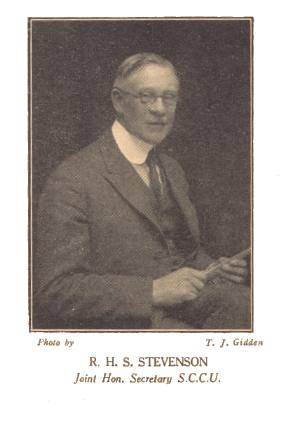
Board 14: James Frederick Chance (1856-1938) came from a prominent family of glass manufacturers in the Black Country but later devoted his life to the study of history. In 1911 he was in Offchurch, near Leamington Spa, visiting his sister Eleanor and her husband, a retired clergyman named William Bedford. They were living next door to the vicarage where James Agar-Ellis employed my great aunt Ada Padbury as a cook. He was a long-standing member of the Imperial Chess Club, serving as president from 1934 until his death. His obituary in the BCM described him as being a chess player of medium strength.
Here he is, in 1935, playing the young Elaine Saunders.

Board 15: Julian Veitch Jameson (1880-1932) came from a family with Irish and Scottish connections as well as links to both India and Kenya. In 1891 he was living in Bowden Hall, Great Bowden, near Market Harborough, where he might, I suppose, have met some of my father’s relations. He later worked as an indigo planter in India. His middle name came from his grandmother Mary Jane Veitch, so he may have been distantly related to Sultan Khan’s opponent. He was active in chess circles for the last few years of his life, scoring 50% in the 2nd Class B section at the 1929 British Championship in Ramsgate, when he was living in Chalfont St Giles, but later moving to Folkestone, where he drew with Yates in a 1931 simul. His son Thomas played cricket for Hampshire.
This photograph from an online family tree shows Julian with a friend.
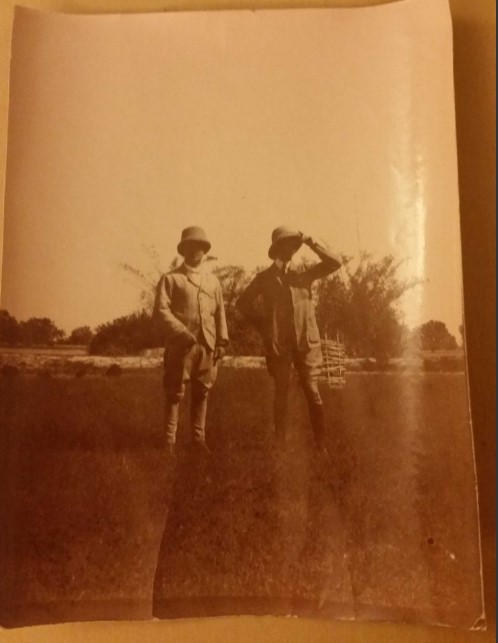
Board 16: Miss Mary Ann Eliza Andrews (1863-1954) was born on the island of Jersey, but her family later moved to Brighton. Her brother, William Richard Andrews, was a prominent Sussex player. She later worked as a schoolmistress. In 1921 she was living in New Cross, South London, in the same road as Jack Redon and his family, but teaching at Halley Road School in Limehouse, north of the Thames. She only seems to have taken up competitive chess on her retirement, playing in the British Ladies Championship in 1923, 1926, and in 8 consecutive years from 1928 to 1935. Her best scores were 8/11 in 1934, and 7/11 in 1930, 1931 and 1932. In 1928 she shared first place in the 2nd Class B section of the West of England Championships (well ahead of Arthur Lowther), but lost this game to the other joint winner, who was killed by a Japanese sniper in Burma in 1944.
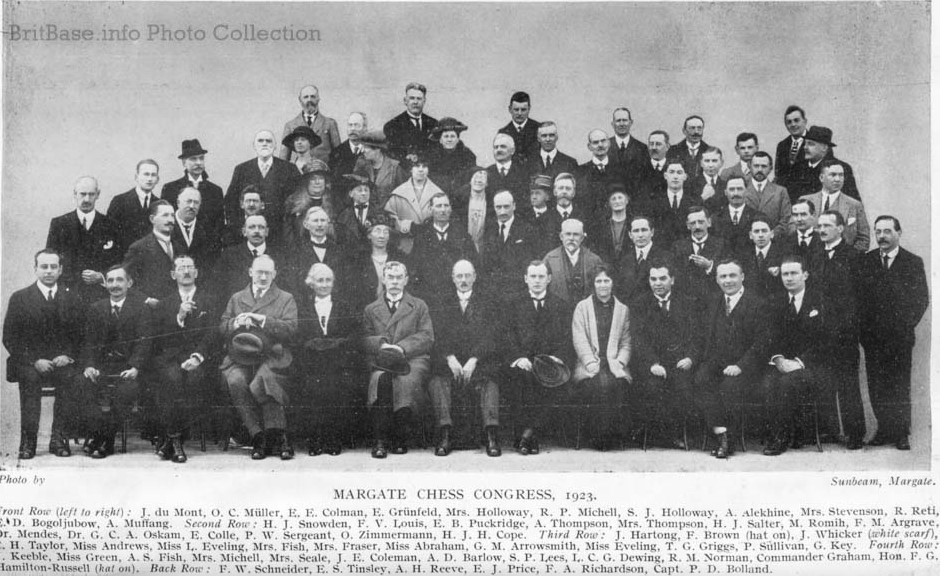
Miss Andrews is the lady wearing what looks like a fur stole centre left, with Lilly Eveling next to her. Lilly’s sister Clara is further along the same row towards the right. If you visit BritBase here you can hover over the faces to identify the names.
Board 17: FH George. I have no information about this player. Seemingly not connected to TH George of Ilford, who would have been on a much higher board. There was a player of that age who lost all his games in a junior tournament in Ramsgate in 1929. There was a Frank Harold George from London (1870-1940) who was, intriguingly, a Comedian in 1911, and working for Harrods as a Clerk in the Counting House in 1921. This might, I suppose, have been him.
Board 18: Major General Nawab Sir Umar Hayat Khan Tiwana (1874-1944) was a soldier of the Indian Empire, one of the largest landholders in the Punjab, and an elected member of the Council of State of India, who had brought Sultan Khan to London and promoted his chess career. He must also have been a reasonably strong player himself.
Board 19: Mrs Latham is something of a mystery. She played in the 1907 Ostend Ladies tournament, then joined the Ladies club in London, moving on, like many of her clubmates, to the Imperial Chess Club, where she played at least up to this match. She can be seen in a photograph of a reception held for Alekhine in 1932, but she was never awarded even an initial, let alone a first name. Can anyone out there help identify her?
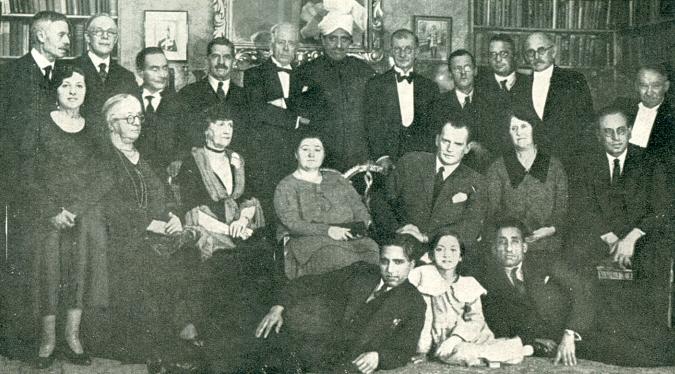
Mrs Latham is the lady seated on the left, with Mrs Arthur Rawson next to her. You’ll then spot Vera Menchik and Alekhine, with Sultan Khan on the floor on the right. Other participants on the liner included RHS Stevenson (2nd left top row), C Wreford-Brown (4th left top row), next to him Sir Ernest Graham-Little, and then Sir Umar Hayat Khan. Edward Winter provides the full list of names here (you’ll have to scroll down a bit). Note that A Rutherford is not related to VH Rutherford.
Board 20: Mrs M Healey is another mystery. She played in some tournaments in the late 1920s when she was living in South Croydon, and again in the late 1930s by which time she had moved to Hastings. She won a prize at Hastings in 1938 for the best score by a lady in the Second Class section. It’s not clear whether M was her or her husband’s initial.
Board 21: Arthur Newton Streatfeild (1859-1956) was secretary of the Carlton Club for many years. He doesn’t appear to have been a competitive chess player. A member of a distinguished family (note the spelling) who would therefore have had a family connection with his teammate on Board 13.
Board 22: most likely to be Harry Norman Hunter (1883-1966?), a music salesman/publisher originally from Sunderland. In 1921 he was working for Francis, Day & Hunter: the Hunter comes from the music hall composer and performer Harry Hunter, whose real name was William Henry Jennings, and seems to have had no connection with Harry Norman Hunter. I can’t find any other record of him playing chess.
Board 23: Miss Lilly Eveling (1867-1951) came from a prosperous family of drapers in Kent. She played competitively from 1913 up to the second world war, but with little success, scoring only 1/11 in both her appearances in the British Ladies Championship, in 1930 and 1931. Her sister Clara was also a chess player.
Board 24: Henry Bell (1858-1935) was a banker and financier, rising to become general manager of Lloyds Bank, and also a Director until his retirement in 1924. In that year he unsuccessfully stood for parliament representing the Liberal Party in a by-election for the City of London constituency. He was also the President of the Imperial Chess Club for several years.
Board 25: Sir Thomas William Richardson (1865-1947) was a former civil servant and High Court judge in India, who, on returning to England, was very much involved with promoting the development of municipal housing in Fulham.
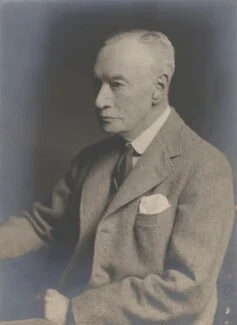
Board 26: Mrs Fitzgerald. The full name and dates of this player are currently unknown to me.
Board 27: likely to be Miss Marion Isabella McCombie (1866-1936), the daughter of a quill merchant. I have no further information about her chess.
Board 28: Mrs Yuill The full name and dates of this player are again currently unknown to me.
Board 29: Mrs Ella (Ellen on her birth record) Frances Rawson (née Bremner) (1856-1942) was the founder of the Imperial Chess Club and a promoter of chess for women and girls. Born in Glasgow, she emigrated to New Zealand where she married Arthur Rawson. Her husband died in 1894, and in about 1909 she moved to London, where she founded the Imperial Chess Club. I’ll write more about this in a future Minor Piece. Although purely a social player herself she was a very important figure in London chess in the inter-war years.
Board 30: Florence Mary (Miles-)Bailey (née Hobson) (1866-1952), daughter of a master builder and widow of a stockbroker, who achieved some fame by playing chess on long-distance aeroplane flights (see here). Although some of her games took place at a high level, her standard of play was probably at a relatively low level.
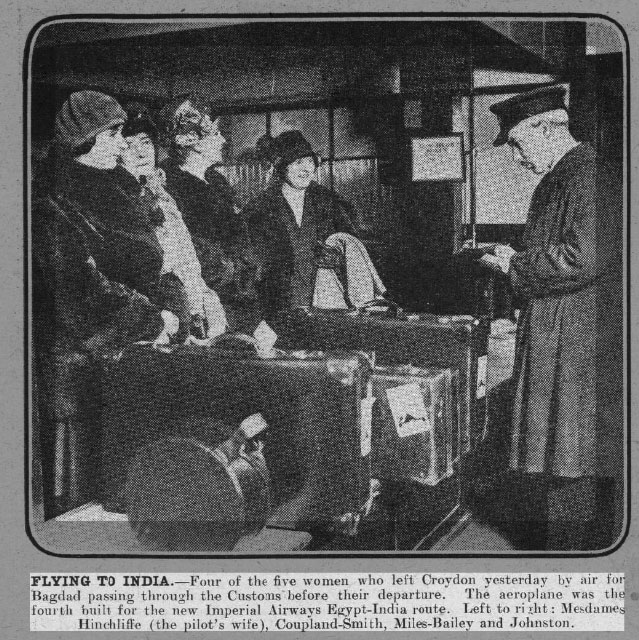
Board 31: Sir Ernest Gordon Graham Graham-Little (1867-1950) was a dermatologist and Independent MP for London University from 1924 to 1950. If he’d stood for election there in 1922 or 1923 he’d have faced the novelist and chess enthusiast HG Wells, who unsuccessfully represented the Labour Party. Although not a strong player himself, Sir Ernest was a great patron of chess who rarely missed an opportunity to support his favourite game.
Board 32: Hon Mildred Dorothea Gibbs (1876-1961), known as Minnie in her family, was a daughter of the 2nd Baron Aldenham, a Conservative politician from a famous banking family.
From a family website: Quartermaster of London Voluntary Aid Detachment No. 30 of the British Red Cross Society, 1910; commandant of No. 116, 1913. Served with Bulgaria Red Cross Society in Kirk Kilisse 1912-13 (decorated by the Queen of Bulgaria). In the Great War, amongst other V.A.D. services in London, was in 1915 successively a Nurse at Westminster V.A.D. Hospital, in charge of a Belgian Refugee Convalescent Hostel, and on Air Raid duty; and, from October 1915 to November 1918, Head of the Posting Department of County of London Branch of the Bulgaria Red Cross Society. Attached to the Westminster Division of the B.R.C.S. October 1919, sometime temporary secretary and vice-chairman, chairman 1926-8. Resigned V.A.D. 1929. ‘Member’ 1918, ‘Officer’ 1919, of the Order of the British Empire. Member of the Church of England National Assembly from 1925.
She’s the girl on the right in this charming family photograph.
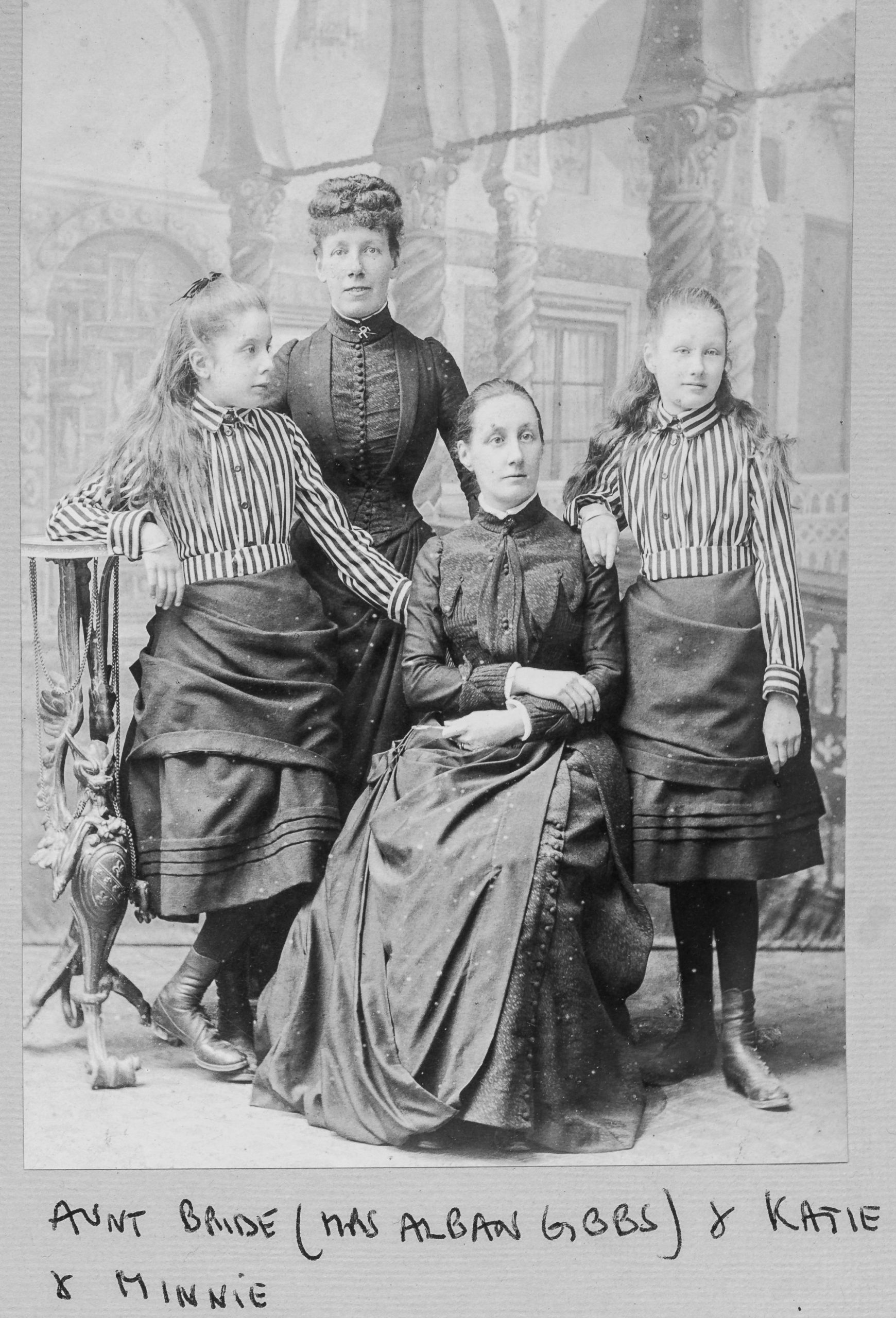
You’ll immediately notice a few things about the Imperial team. Most obviously, there are 13 ladies amongst the 32 players, although mostly on the lower boards. They’re all from upper middle class or even minor aristocratic backgrounds. They’re mostly older, with many born back in the 1850s and 1860s. Apart from Sultan Khan, the youngest was Amy Wheelwright, born in 1890.
And here they all are: the players from both teams: you can see a larger version, thanks to Edward Winter, here.

I can add a little about the top three players in Lord Kylsant’s team.
Board 1: William Veitch (1877-1957) was born in Kincardineshire in the East of Scotland, which is where his surname originates. His family moved down to Hampshire, where he played for Southampton and Hampshire in the years before the First World Wat, then moving to the Lewisham area of London, where, in the 1939 Register, he was described as a Ship Owner’s Clerk. Playing on a high board for his club and a lower board for his county, he was a decent above average club standard player.
Board 2: Leslie Alec Seymour Howell (1900-1959: Alec Leslie on his birth record) was a shipping accounts clerk from the Edmonton/Tottenham area of North London, working for the Royal Mail Line. I have no other record of him playing competitive chess, but he was clearly a decent player. Here he is, pictured with his wife, Hilda.

Board 3: David(?) Storrar. Another rather unusual surname, again from the East of Scotland, so it shouldn’t be too hard to track him down. Here we hit a problem. D Storrar from Plaistow was solving chess problems in the Daily News in 1904. There was a D Storrar living in Islington in 1911, born in Perth in 1889, but he worked in banking, not in shipping. There was also a David Storrar on the electoral roll in East Ham (adjacent to Plaistow but some way from Islington) in 1913 and 1915. These three may be all the same person, or two or three different people. The 1911 Islington Storrar is apparently the same person as the David Duncan Storrar who married in Westminster in 1933, and died in Kampala in 1944, having worked for the National Bank of India. We can also pick him up in Aberfeldy, Perthshire, in the Scottish 1921 census, again described as a banker. If this is our man he must have been a ringer. Perhaps the East London 1904/1913/1915 David Storrar is a different, chess-playing, shipping person but I can’t find him on any census records or family trees. Who knows?
As a result of my problems with Mr Storrar, I decided not to go any further down Lord Kylsant’s list. None of the names looks familiar: I presume that, apart from Veitch, who had played competitively 20 years earlier, they were purely social players.
But what of Lord Kylsant himself. I’m sure you want to know more.

He was Owen Cosby Philipps (1863-1937), who had been a Liberal MP from 1906 to 1910, and then, switching allegiance, a Conservative MP between 1916 and 1922. His family also ran a shipping company, and he became involved with the Royal Mail Steam Packet Company, of which he became managing director in 1902. They gradually took control of various other shipping companies, including the Union-Castle Line, whose ship the Llangibby Castle, which had only been launched the previous year, served as the venue for this match.
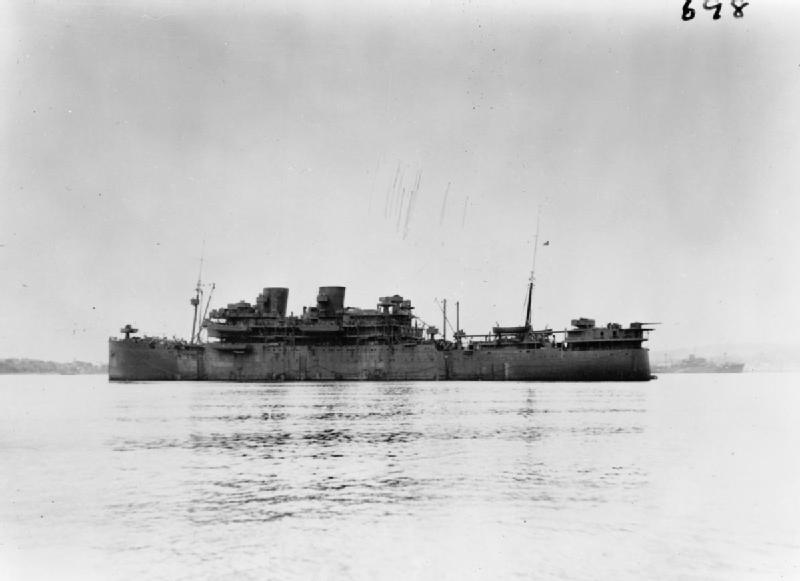
All was not well with the company, though. In 1928 investigations began looking into financial irregularities, and this match may well have been part of a charm offensive to garner favourable publicity before the trial took place. The nub of the issue seems to have been that they were accused of misleading potential investors about the company’s financial health.
When the trial took place in 1931 Kylsant, despite the efforts of his defence team led by Imperial Chess Club Vice-President Sir John Simon, was found guilty on one charge, and sentenced to a year’s imprisonment, of which he served 10 months in Wormwood Scrubs. Large companies these days get away with far worse crimes.
If you have any corrections or further information about any of the players in this match, especially about those I’ve been unable to identify, please let me know.
There’s a lot more to write about the Imperial Chess Club: there will be further posts going backwards and forwards in time and introducing you to more of their members.
But first, taking a different view of the social function of chess in the inter-war years, there’s a significant anniversary to celebrate later this month.
Join me soon for another Minor Piece.
Sources and Acknowledgements:
ancestry.co.uk
findmypast.co.uk/British Newspaper Library
Wikipedia
BritBase/John Saunders
Chess Notes/Edward Winter
British Chess Magazine
chessgames.com
ChessBase 18/Stockfish 17
Gibbs, Jameson, Howell and Hooke websites/family trees
Kingston Chess Club website
Other sources linked to above
We remember IM Adam Hunt who passed away on Tuesday, December 3rd 2024 following a nine year battle with cancer.
Adam Ceiriog Hunt was born on Tuesday, October 21st, 1980 in Oxford and his mother’s maiden name was Williams. The UK Number one single was “Woman in Love” by Barbara Streisand. Adam shared his birthday with Kim Kardashian.
(Ceiriog was the bardic name of John Ceiriog Hughes (1832–87)
Adam attended The Cherwell School and The University of Sussex to study general biology.

Adam became an International Master in 2001 and then a FIDE Trainer in 2016. According to Felice and Megabase 2020 his attained his peak FIDE rating of 2466 in January 2008 at the age of 28.
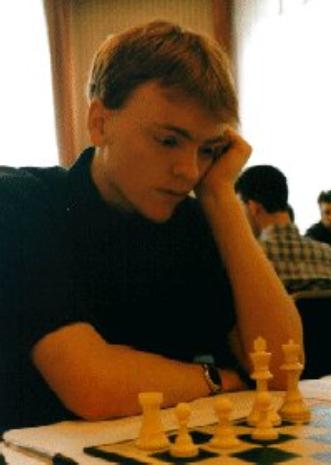
In 2004 Adam was living in Headington, Oxfordshire and in 2007 he moved to Ipswich in Suffolk and was married in 2019. Recently, Adam and his partner became parents to Henry.
As a junior (and together with Harriet) Adam first played for Cowley Chess Club.
Most recently Adam played for 4NCL Blackthorne Russia, prior to that Bettson.com, Midlands Monarchs and Perceptron Youth with Witney being his original team.
He was Director of Chess at Woodbridge School in Suffolk and was the brother of IM Harriet Hunt
With the white pieces is (almost exclusively) an e4 player playing the main line of Ruy Lopez (8.c3) and favouring the Fischer-Sozin against the Najdorf.
As the second player Adam played the Sicilian Najdorf and a 50:50 mixture of the King’s Indian and Grünfeld Defences.
Adam was the brother of IM Harriet Hunt
